A Comprehensive Review of Catalytic Hydrodeoxygenation of Lignin-Derived Phenolics to Aromatics
Abstract
1. Introduction
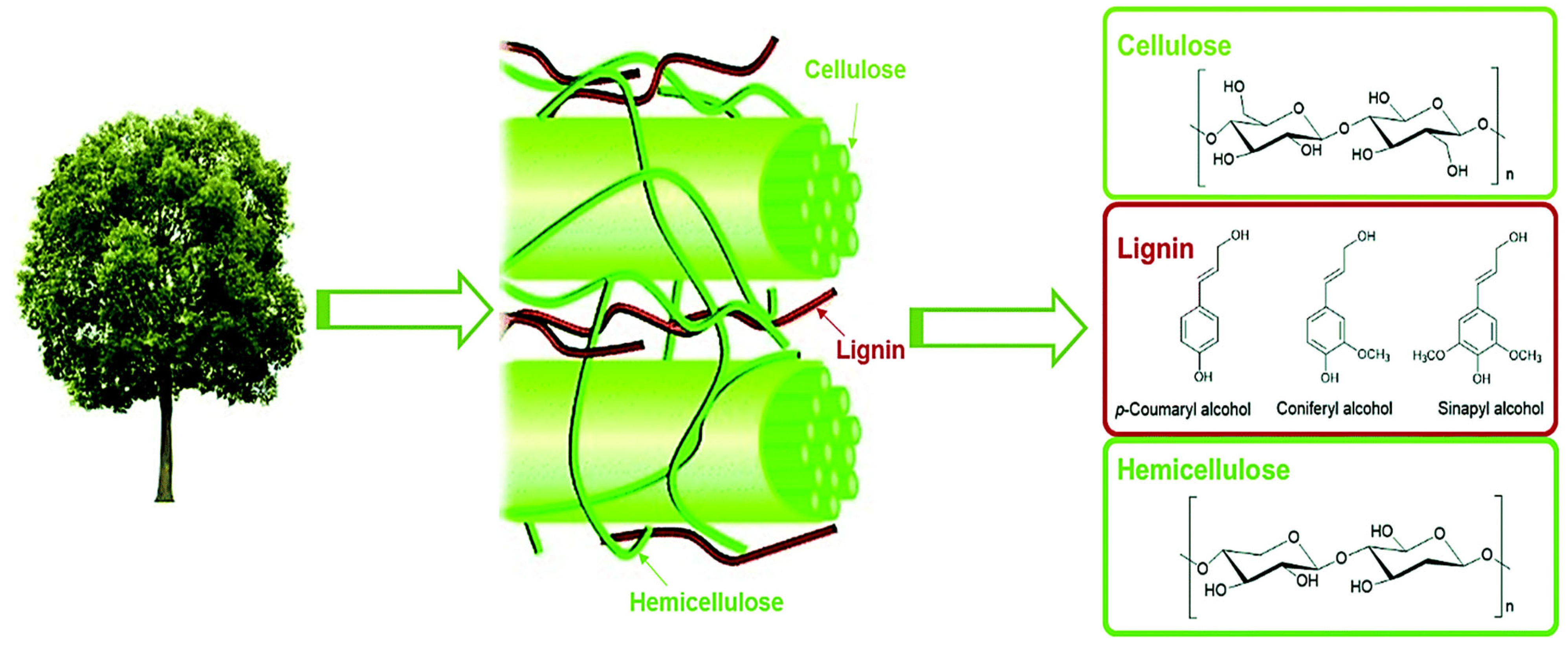
2. Catalytic Conversion of Phenolics into Aromatics
2.1. Noble Metal Catalysts
2.1.1. Palladium (Pd)-Based Catalysts
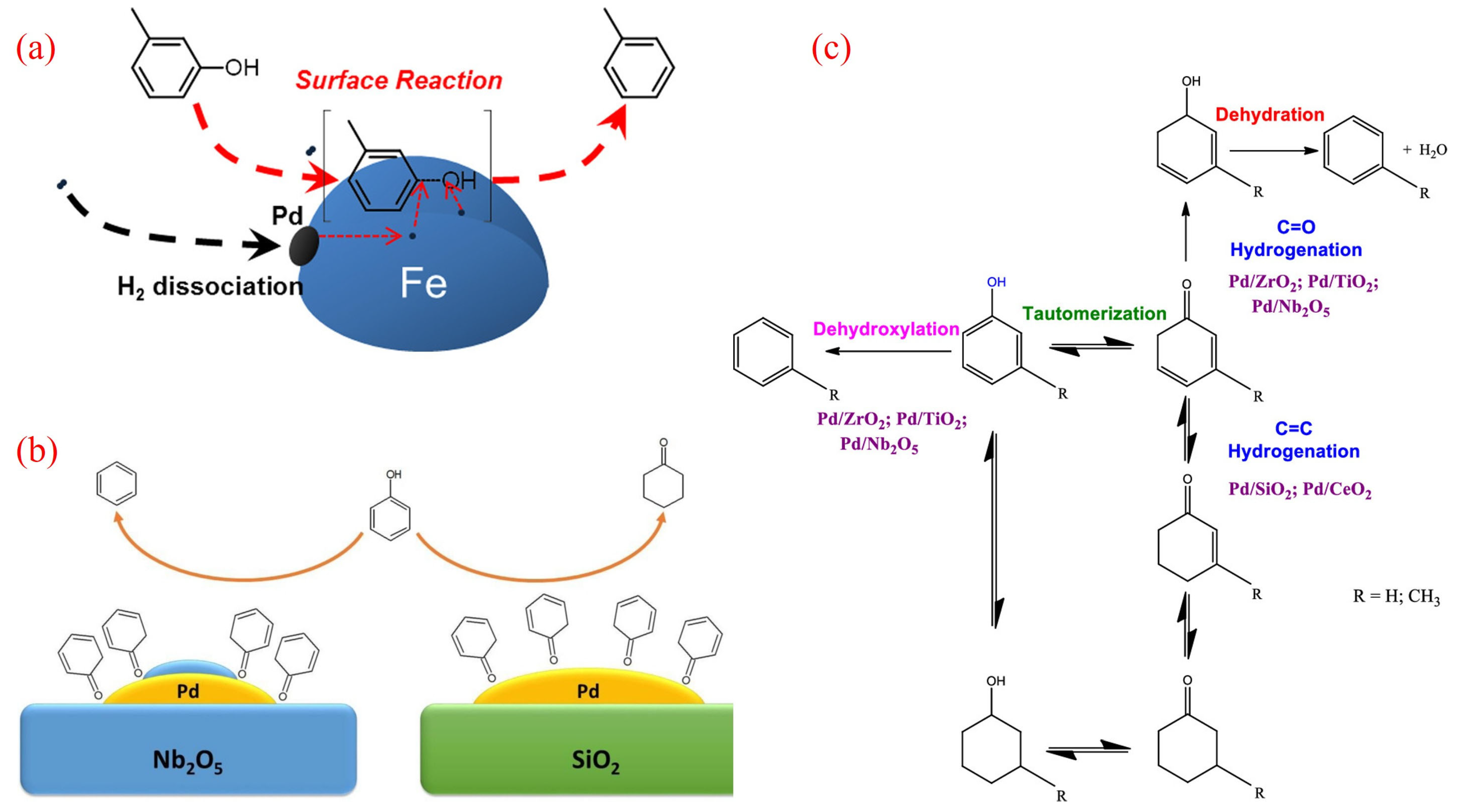
2.1.2. Ruthenium (Ru)-Based Catalysts
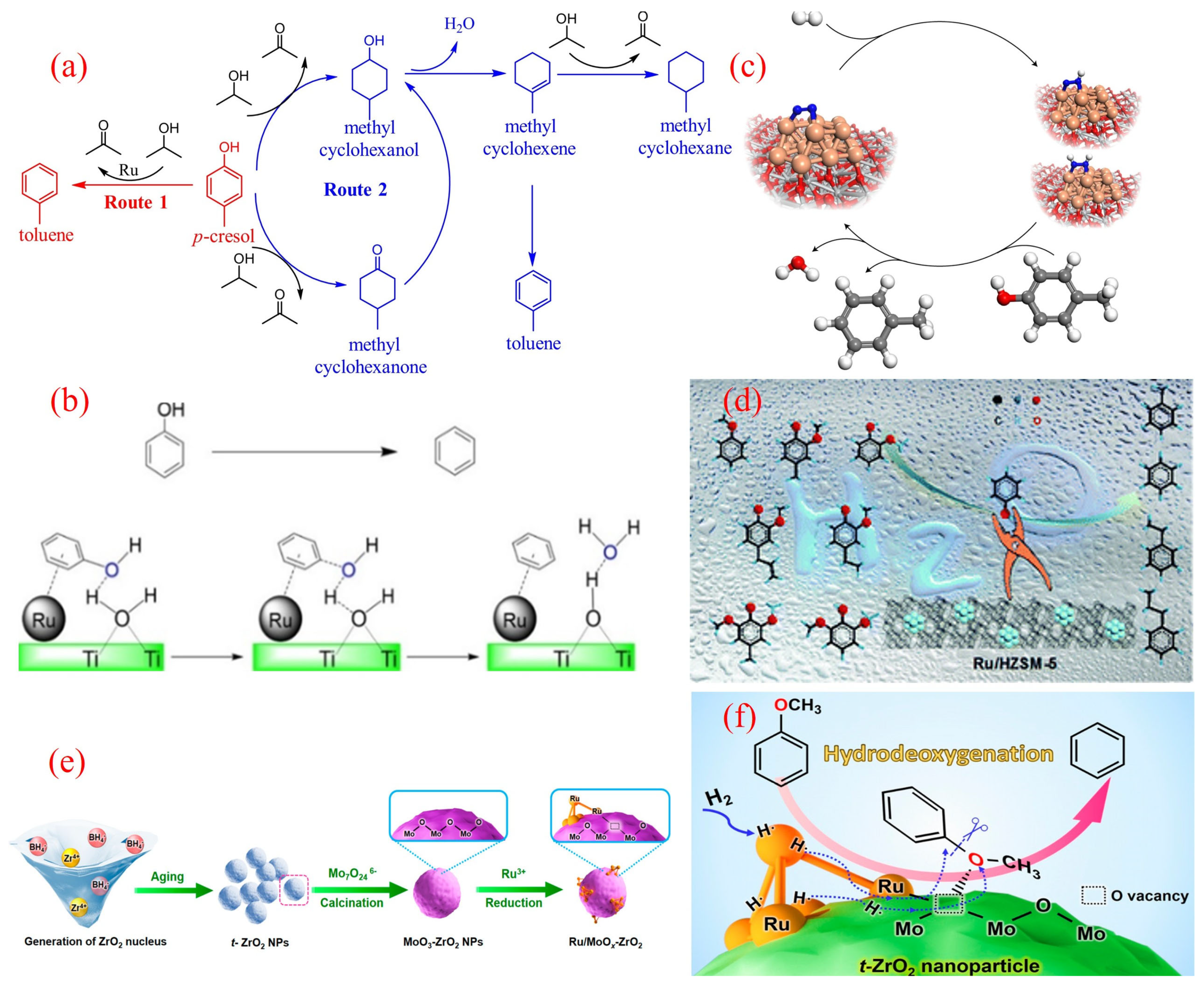
2.1.3. Platinum (Pt)-Based Catalysts
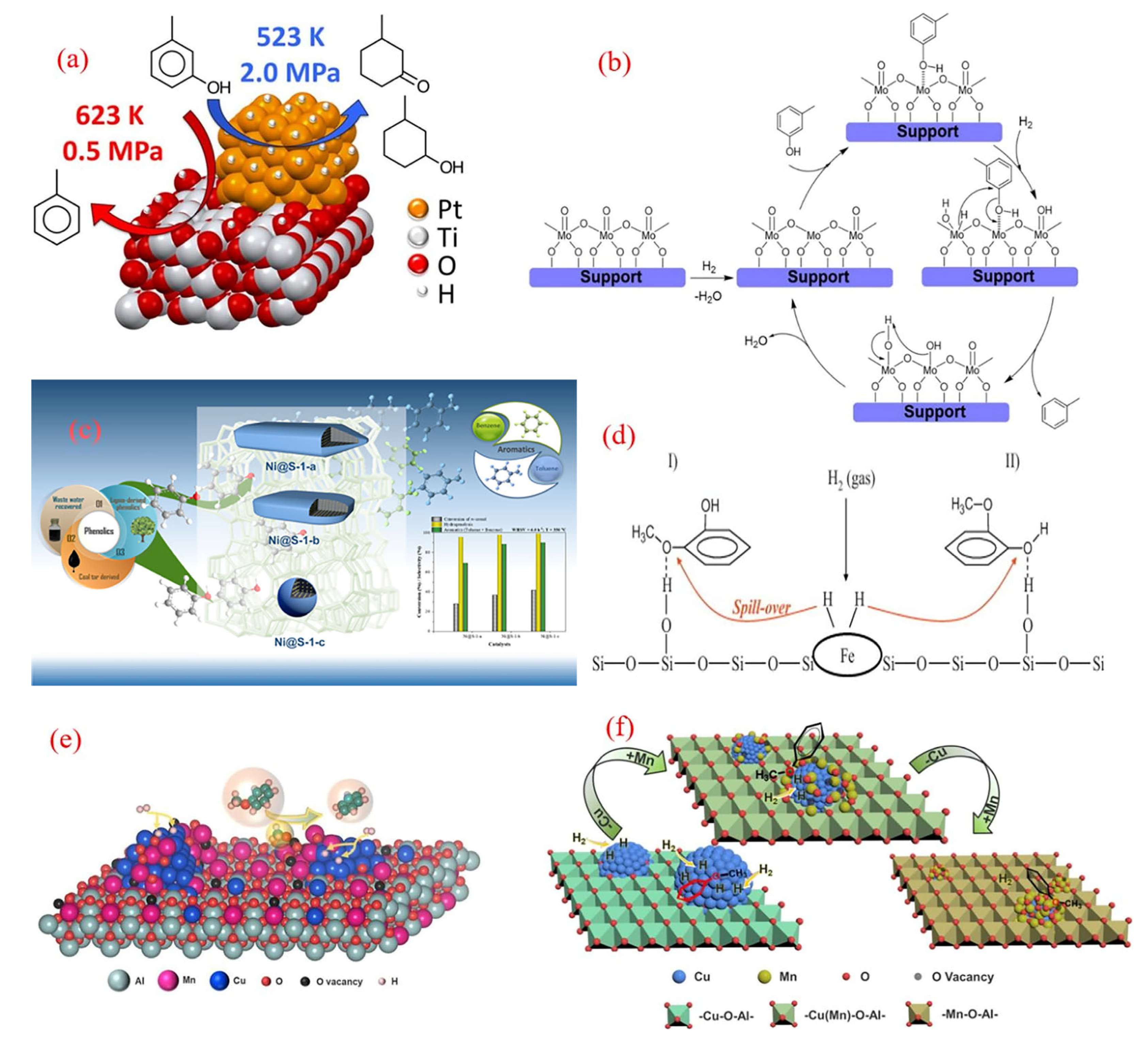
2.2. Non-Noble Metal Catalysts
2.3. Bimetallic Catalysts
2.3.1. Fe-Containing Bimetallic Catalysts
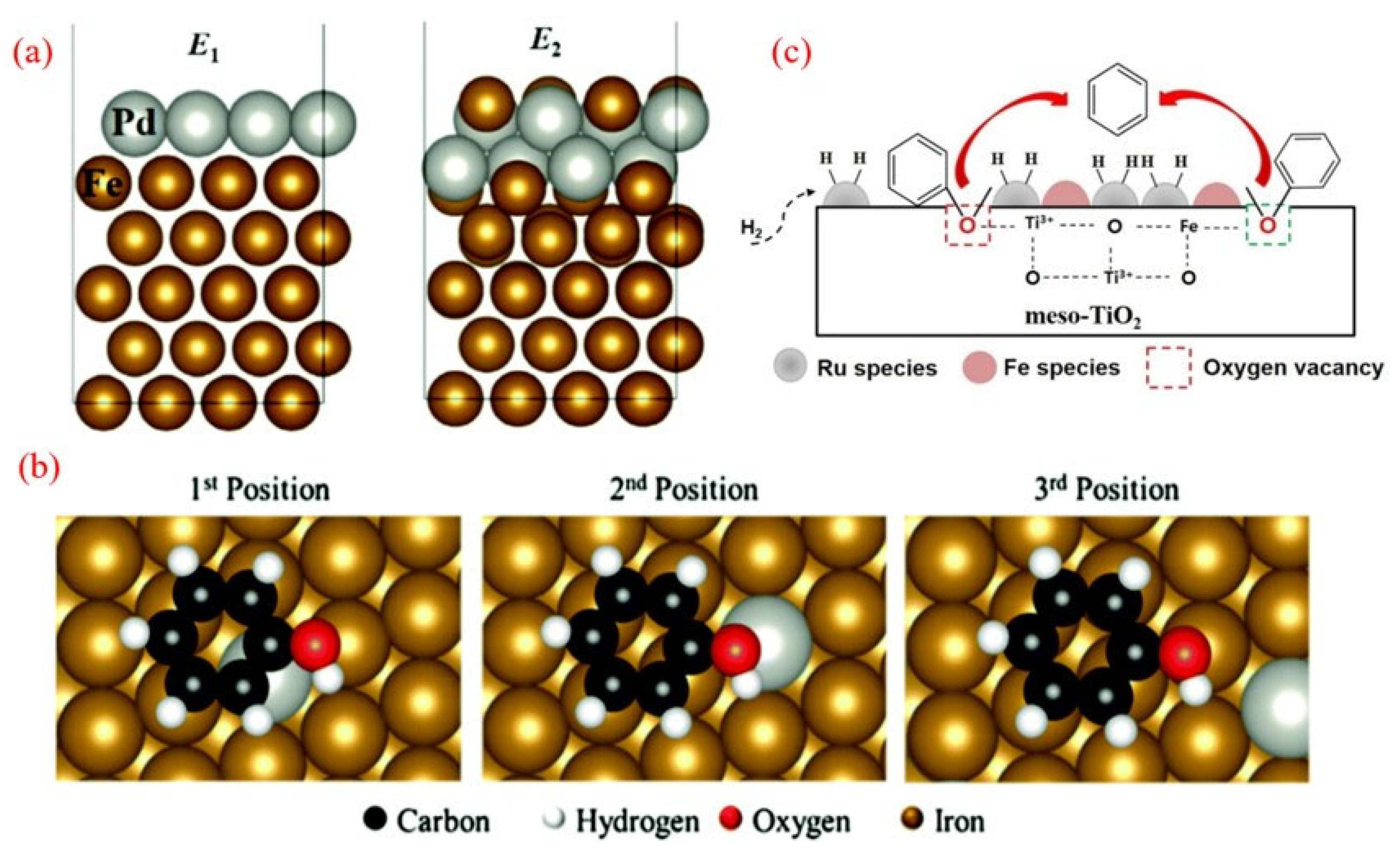
2.3.2. Ni-Containing Bimetallic Catalysts
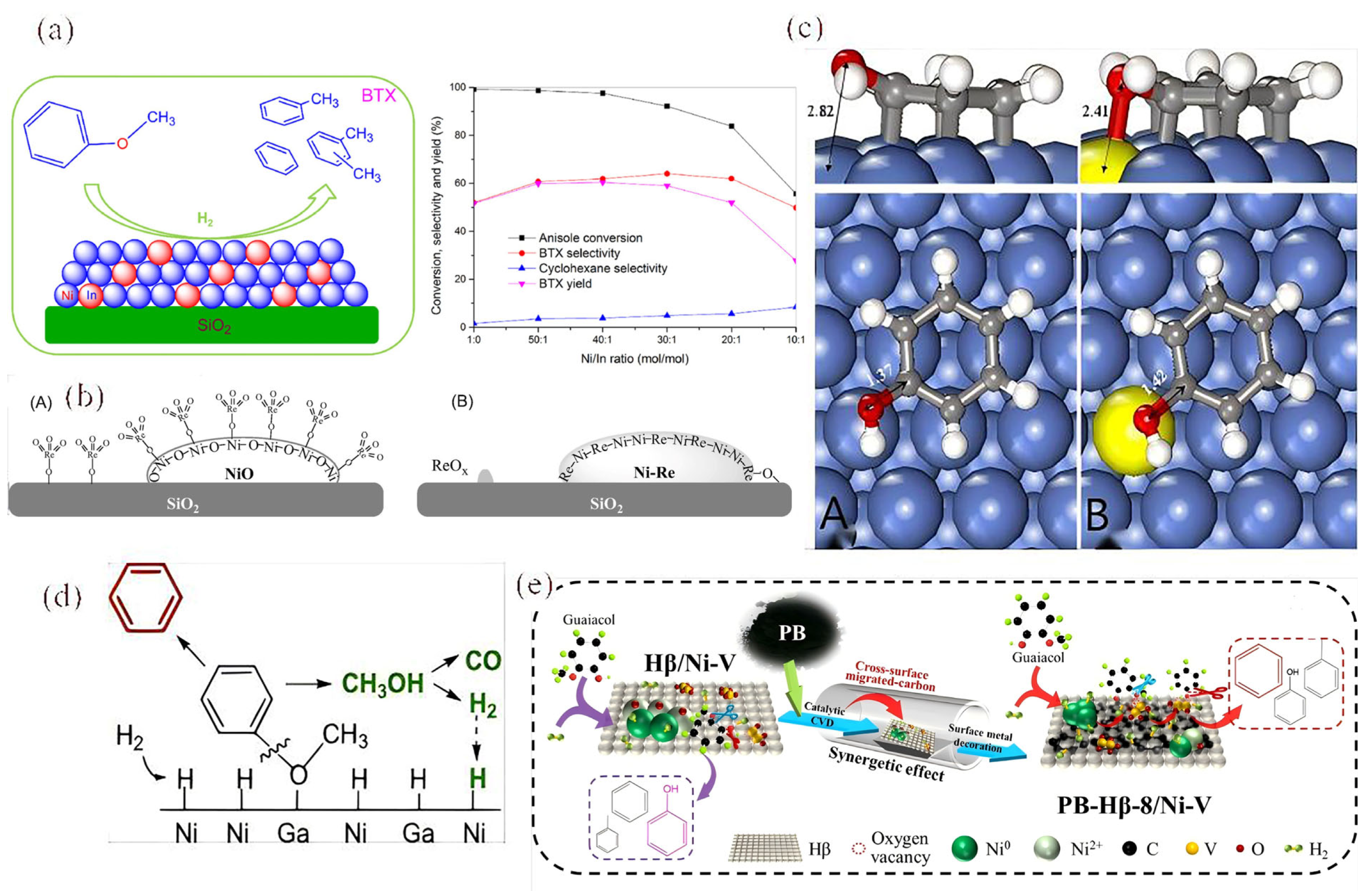
2.3.3. Re- and W-Based Bimetallic Catalysts
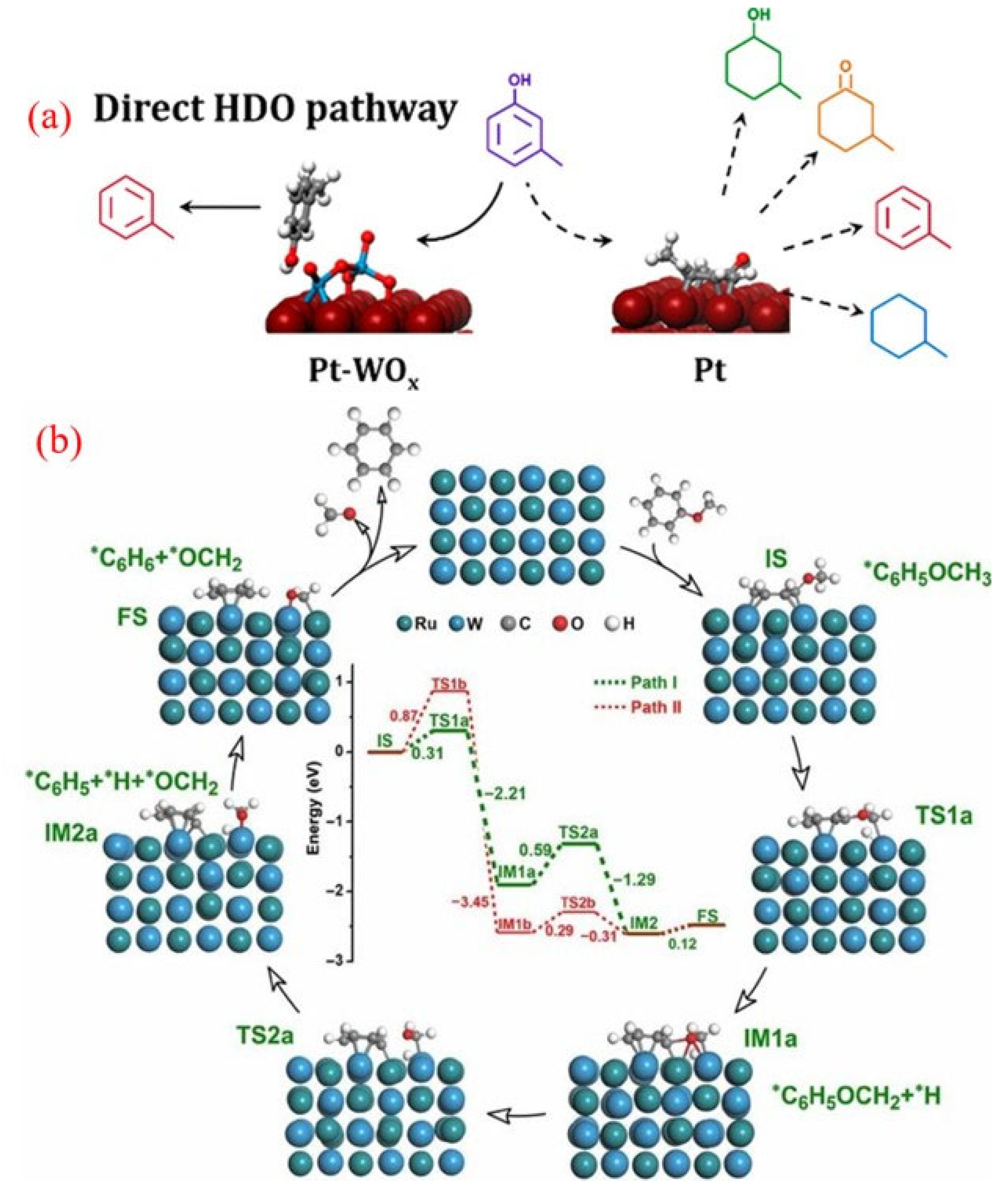
2.4. Transition Metal-Based Catalysts
2.4.1. Metal Sulfide Catalysts
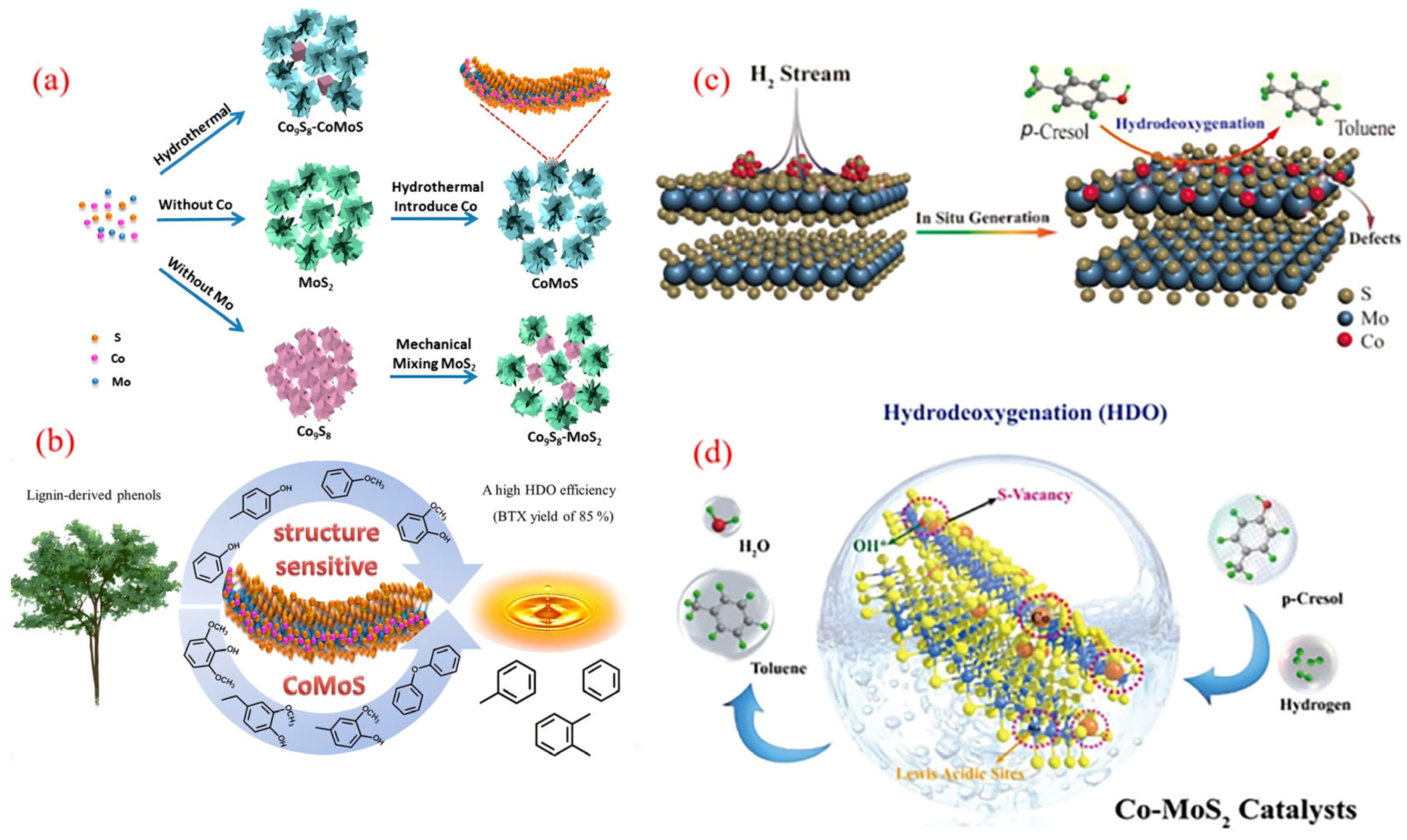
2.4.2. Transition Metal Phosphides
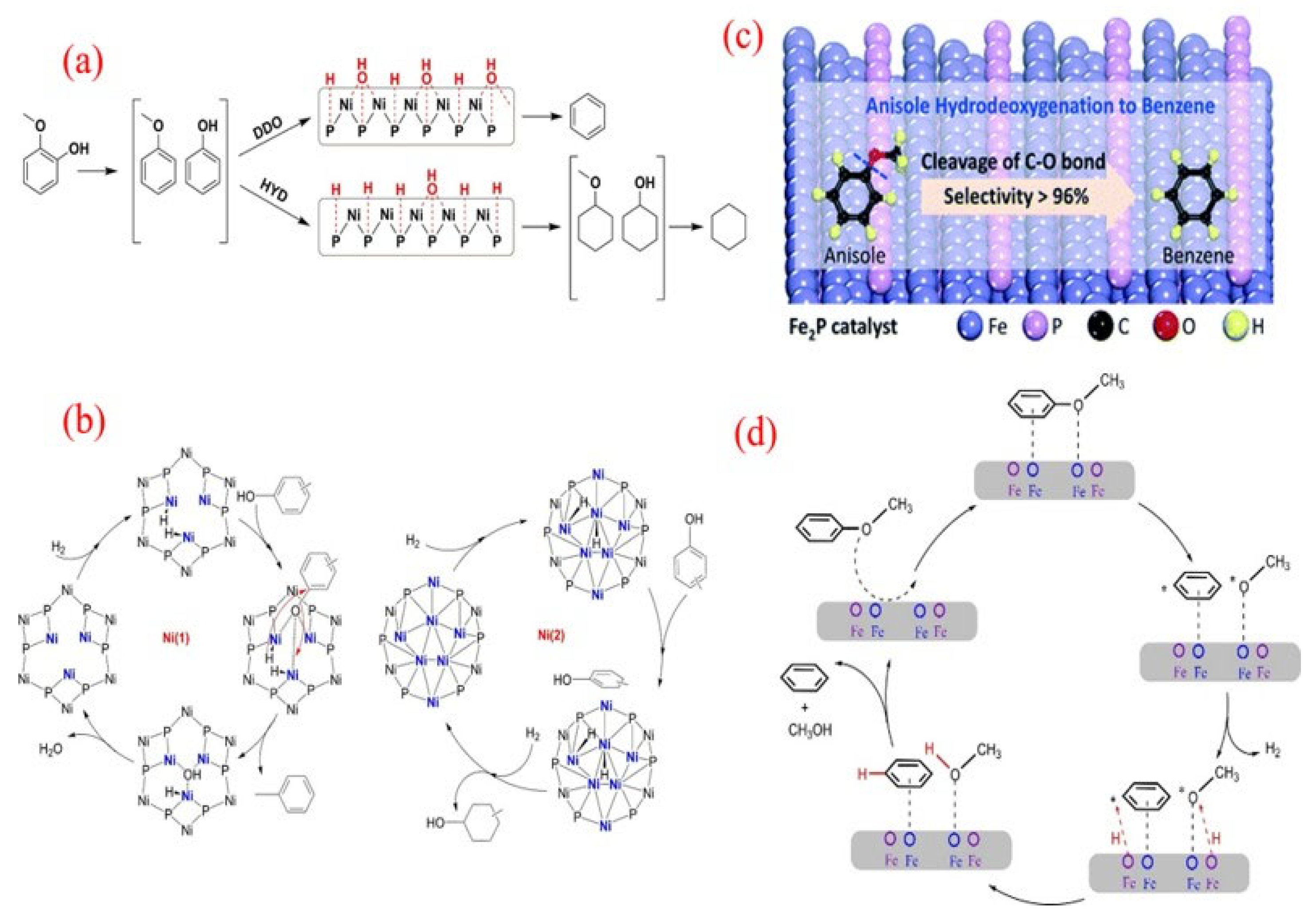
2.4.3. Transition Metal Carbides, Nitrides
3. Conclusions and Perspectives
Author Contributions
Funding
Conflicts of Interest
References
- Ye, K.; Liu, Y.; Wu, S.; Zhuang, J. A review for lignin valorization: Challenges and perspectives in catalytic hydrogenolysis. Ind. Crops Prod. 2021, 172, 114008. [Google Scholar] [CrossRef]
- Shu, R.; Li, R.; Lin, B.; Wang, C.; Cheng, Z.; Chen, Y. A review on the catalytic hydrodeoxygenation of lignin-derived phenolic compounds and the conversion of raw lignin to hydrocarbon liquid fuels. Biomass Bioenergy 2020, 132, 105432. [Google Scholar] [CrossRef]
- Zhou, C.-H.; Xia, X.; Lin, C.-X.; Tong, D.-S.; Beltramini, J. Catalytic conversion of lignocellulosic biomass to fine chemicals and fuels. Chem. Soc. Rev. 2011, 40, 5588–5617. [Google Scholar] [CrossRef]
- Sun, Z.; Fridrich, B.; de Santi, A.; Elangovan, S.; Barta, K. Bright Side of Lignin Depolymerization: Toward New Platform Chemicals. Chem. Rev. 2018, 118, 614–678. [Google Scholar] [CrossRef]
- Amidon, T.E.; Liu, S. Water-based woody biorefinery. Biotechnol. Adv. 2009, 27, 542–550. [Google Scholar] [CrossRef]
- Martínez Angel, T. How to break down crystalline cellulose. Science 2016, 352, 1050–1051. [Google Scholar] [CrossRef]
- Lang, M.; Li, H. Sustainable Routes for the Synthesis of Renewable Adipic Acid from Biomass Derivatives. ChemSusChem 2022, 15, e202101531. [Google Scholar] [CrossRef]
- Árvai, C.; Medgyesi, Z.; LUI, M.; Mika, L. The Chemistry of Levulinic Acid: Its Potential in the Production of Biomass—Based Chemicals. Adv. Synth. Catal. 2024, 366, 4846–4888. [Google Scholar] [CrossRef]
- Liu, Y.; Chen, L.; Wang, T.; Zhang, Q.; Wang, C.; Yan, J.; Ma, L. One-Pot Catalytic Conversion of Raw Lignocellulosic Biomass into Gasoline Alkanes and Chemicals over LiTaMoO6 and Ru/C in Aqueous Phosphoric Acid. ACS Sustain. Chem. Eng. 2015, 3, 1745–1755. [Google Scholar] [CrossRef]
- Sun, Z.; Bottari, G.; Afanasenko, A.; Stuart, M.C.A.; Deuss, P.J.; Fridrich, B.; Barta, K. Complete lignocellulose conversion with integrated catalyst recycling yielding valuable aromatics and fuels. Nat. Catal. 2018, 1, 82–92. [Google Scholar] [CrossRef]
- Wijaya, Y.P.; Smith, K.J.; Kim, C.S.; Gyenge, E.L. Electrocatalytic hydrogenation and depolymerization pathways for lignin valorization: Toward mild synthesis of chemicals and fuels from biomass. Green Chem. 2020, 22, 7233–7264. [Google Scholar] [CrossRef]
- Carpenter, D.; Westover, T.L.; Czernik, S.; Jablonski, W. Biomass feedstocks for renewable fuel production: A review of the impacts of feedstock and pretreatment on the yield and product distribution of fast pyrolysis bio-oils and vapors. Green Chem. 2014, 16, 384–406. [Google Scholar] [CrossRef]
- Akhtari, S.; Sowlati, T.; Day, K. Economic feasibility of utilizing forest biomass in district energy systems—A review. Renew. Sust. Energ. Rev. 2014, 33, 117–127. [Google Scholar] [CrossRef]
- Ruppert, A.M.; Weinberg, K.; Palkovits, R. Hydrogenolysis Goes Bio: From Carbohydrates and Sugar Alcohols to Platform Chemicals. Angew. Chem. Internat. Edit. 2012, 51, 2564–2601. [Google Scholar] [CrossRef]
- Wang, H.; Zhu, C.; Li, D.; Liu, Q.; Tan, J.; Wang, C.; Cai, C.; Ma, L. Recent advances in catalytic conversion of biomass to 5-hydroxymethylfurfural and 2, 5-dimethylfuran. Renew. Sust. Energ. Rev. 2019, 103, 227–247. [Google Scholar] [CrossRef]
- Liao, Y.; Liu, Q.; Wang, T.; Long, J.; Zhang, Q.; Ma, L.; Liu, Y.; Li, Y. Promoting Hydrolytic Hydrogenation of Cellulose to Sugar Alcohols by Mixed Ball Milling of Cellulose and Solid Acid Catalyst. Energ. Fuels 2014, 28, 5778–5784. [Google Scholar] [CrossRef]
- Achyuthan, K.E.; Achyuthan, A.M.; Adams, P.D.; Dirk, S.M.; Harper, J.C.; Simmons, B.A.; Singh, A.K. Supramolecular self-assembled chaos: Polyphenolic lignin’s barrier to cost-effective lignocellulosic biofuels. Molecules 2010, 15, 8641–8688. [Google Scholar] [CrossRef]
- Mateo, S.; Fabbrizi, G.; Moya, A. Lignin from Plant—Based Agro—Industrial Biowastes: From Extraction to Sustainable Applications. Polymers 2025, 17, 952. [Google Scholar] [CrossRef]
- Shu, R.; Zhang, Q.; Ma, L.; Xu, Y.; Chen, P.; Wang, C.; Wang, T. Insight into the solvent, temperature and time effects on the hydrogenolysis of hydrolyzed lignin. Bioresour. Technol. 2016, 221, 568–575. [Google Scholar] [CrossRef]
- Ma, H.; Li, H.; Zhao, W.; Li, L.; Liu, S.; Long, J.; Li, X. Selective depolymerization of lignin catalyzed by nickel supported on zirconium phosphate. Green Chem. 2019, 21, 658–668. [Google Scholar] [CrossRef]
- Shu, R.; Long, J.; Yuan, Z.; Zhang, Q.; Wang, T.; Wang, C.; Ma, L. Efficient and product-controlled depolymerization of lignin oriented by metal chloride cooperated with Pd/C. Bioresour. Technol. 2015, 179, 84–90. [Google Scholar] [CrossRef] [PubMed]
- Cao, L.; Yu, I.; Liu, Y.; Ruan, X.; Tsang, D.; Hunt, A.; Ok, Y.; Song, H.; Zhang, S. Lignin valorization for the production of renewable chemicals: State-of-the-art review and future prospects. Bioresour. Technol. 2018, 269, 465–475. [Google Scholar] [CrossRef]
- Zhang, X.; Lei, H.; Chen, S.; Wu, J. Catalytic co-pyrolysis of lignocellulosic biomass with polymers: A critical review. Green Chem. 2016, 18, 4145–4169. [Google Scholar] [CrossRef]
- Li, C.; Zhao, X.; Wang, A.; Huber, G.; Zhang, T. Catalytic Transformation of Lignin for the Production of Chemicals and Fuels. Chem. Rev. 2015, 115, 11559–12090. [Google Scholar] [CrossRef]
- Zakzeski, J.; Bruijnincx, P.C.A.; Jongerius, A.L.; Weckhuysen, B.M. The Catalytic Valorization of Lignin for the Production of Renewable Chemicals. Chem. Rev. 2010, 110, 3552–3599. [Google Scholar] [CrossRef]
- Sirous-Rezaei, P.; Jae, J.; Ha, J.-M.; Ko, C.H.; Kim, J.M.; Jeon, J.-K.; Park, Y.-K. Mild hydrodeoxygenation of phenolic lignin model compounds over a FeReOx/ZrO2 catalyst: Zirconia and rhenium oxide as efficient dehydration promoters. Green Chem. 2018, 20, 1472–1483. [Google Scholar] [CrossRef]
- Sun, Y.; Yang, Z.; Wu, Y.; Tu, R.; Yang, H.; Jiang, E.; Xu, X. Smoke calcination induced C-Ni/VOX triphase interface micro-environment Controls selectivity in guaiacol hydrodeoxygenation. Chem. Eng. J. 2025, 505, 159229. [Google Scholar] [CrossRef]
- LV, W.; Jiang, Y.; Tian, K.; Wang, X.; Li, X.; Tong, J.; Chen, A.; Chen, X. Constructing Ni-MgO wrapped by carbon sphere to prepare a defect-rich catalyst for the conversion of lignin-derived oligomers into hydrocarbons under mild conditions. Chem. Eng. J. 2025, 509, 161057. [Google Scholar]
- Lonchay, W.; Bagnato, G.; Sanna, A. Highly selective hydropyrolysis of lignin waste to benzene, toluene and xylene in presence of zirconia supported iron catalyst. Bioresour. Technol. 2022, 361, 127727. [Google Scholar] [CrossRef]
- Dong, L.; Xin, Y.; Liu, X.; Guo, Y.; Pao, C.; Chen, J.; Wang, Y. Selective hydrodeoxygenation of lignin oil to valuable phenolics over Au/Nb2O5 in water. Green Chem. 2019, 21, 3081–3090. [Google Scholar] [CrossRef]
- Liu, B.; Qi, Y.; Qiu, X.; Zou, H.; Lin, X. Photoelectrocatalytic Pathway for the Preparation of Power-Effective Aviation Fuel Precursors from Lignin. Adv. Funct. Mater. 2025, 35, 2421552. [Google Scholar] [CrossRef]
- Hu, L.; Wei, X.; Xu, M.; Kang, Y.; Guo, X.; Zhang, F.; Zong, Z.; Bai, H. Selective organic phase hydrodeoxygenation of typical phenolic monomers and two lignin oils over highly active Pd/Hβ catalyst for high-grade bio-fuel production. J. Environ. Chem. Eng. 2021, 9, 106599. [Google Scholar] [CrossRef]
- Zhong, J.; Chen, J.; Chen, L. Selective hydrogenation of phenol and related derivatives. Catal. Sci. Technol. 2014, 4, 3555–3569. [Google Scholar] [CrossRef]
- Wang, X.; Arai, M.; Wu, Q.; Zhang, C.; Zhao, F. Hydrodeoxygenation of lignin-derived phenolics—A review on the active sites of supported metal catalysts. Green Chem. 2020, 22, 8140–8168. [Google Scholar] [CrossRef]
- Gundekari, S.; Karmee, S.K. Recent Catalytic Approaches for the Production of Cycloalkane Intermediates from Lignin-Based Aromatic Compounds: A Review. Review 2021, 6, 1715–1733. [Google Scholar] [CrossRef]
- Yan, J.; Li, Z.; Zhang, Y.; Liu, R.; Zhou, L.; Fu, P. Hydrodeoxygenation of lignin phenolic derivatives to aromatics: A review of catalyst functionalization for targeted deoxygenation and active site modification strategies. Fuel Process. Technol. 2023, 250, 107914. [Google Scholar] [CrossRef]
- Wong, S.S.; Shu, R.; Zhang, J.; Liu, H.; Yan, N. Downstream processing of lignin derived feedstock into end products. Chem. Soc. Rev. 2020, 49, 5510–5560. [Google Scholar] [CrossRef]
- Verma, J.; Petru, M.; Goel, S. Cellulose based materials to accelerate the transition towards sustainability. Ind. Crop. Prod. 2024, 210, 118078. [Google Scholar] [CrossRef]
- Olcese, R.N.; Bettahar, M.; Petitjean, D.; Malaman, B.; Giovanella, F.; Dufour, A. Gas-phase hydrodeoxygenation of guaiacol over Fe/SiO2 catalyst. Appl. Catal. B-Environ. 2012, 115–116, 63–73. [Google Scholar] [CrossRef]
- Holladay, J.E.; White, J.F.; Bozell, J.J.; Johnson, D.J.B.F. Top Value-Added Chemicals from Biomass—Volume II—Results of Screening for Potential Candidates from Biorefinery Lignin. Biomass Fuels 2007, 2, 263–275. [Google Scholar]
- Ponnusamy, V.K.; Nguyen, D.D.; Dharmaraja, J.; Shobana, S.; Banu, J.R.; Saratale, R.G.; Chang, S.W.; Kumar, G. A review on lignin structure, pretreatments, fermentation reactions and biorefinery potential. Bioresour. Technol. 2019, 271, 462–472. [Google Scholar] [CrossRef] [PubMed]
- Xu, X.; Jiang, E.; Du, Y.; Li, B. BTX from the gas-phase hydrodeoxygenation and transmethylation of guaiacol at room pressure. Renew. Energy 2016, 96, 458–468. [Google Scholar]
- Hong, Y.; Zhang, H.; Sun, J.; Ayman, K.M.; Hensley, A.J.R.; Gu, M.; Engelhard, M.H.; McEwen, J.-S.; Wang, Y. Synergistic Catalysis between Pd and Fe in Gas Phase Hydrodeoxygenation of m-Cresol. ACS Catal. 2014, 4, 3335–3345. [Google Scholar] [CrossRef]
- Barrios, A.M.; Teles, C.A.; de Souza, P.M.; Rabelo-Neto, R.C.; Jacobs, G.; Davis, B.H.; Borges, L.E.P.; Noronha, F.B. Hydrodeoxygenation of phenol over niobia supported Pd catalyst. Catal. Today 2018, 302, 115–124. [Google Scholar] [CrossRef]
- Ji, N.; Yin, J.; Rong, Y.; Li, H.; Yu, Z.; Lei, Y.; Wang, S.; Diao, X. More than a support: The unique role of Nb2O5 in supported metal catalysts for lignin hydrodeoxygenation. Catal. Sci. Technol. 2022, 12, 3751–3766. [Google Scholar] [CrossRef]
- de Souza, P.M.; Rabelo-Neto, R.C.; Borges, L.E.P.; Jacobs, G.; Davis, B.H.; Resasco, D.E.; Noronha, F.B. Hydrodeoxygenation of Phenol over Pd Catalysts. Effect of Support on Reaction Mechanism and Catalyst Deactivation. ACS Catal. 2017, 7, 2058–2073. [Google Scholar] [CrossRef]
- Teles, C.A.; de Souza, P.M.; Rabelo-Neto, R.C.; Teran, A.; Jacobs, G.; Resasco, D.E.; Noronha, F.B. Hydrodeoxygenation of Lignin-Derived Compound Mixtures on Pd-Supported on Various Oxides. ACS Sustain. Chem. Eng. 2021, 9, 12870–12884. [Google Scholar] [CrossRef]
- Shao, Y.; Xia, Q.; Dong, L.; Liu, X.; Han, X.; Parker, S.F.; Cheng, Y.; Daemen, L.L.; Ramirez-Cuesta, A.J.; Yang, S.; et al. Selective production of arenes via direct lignin upgrading over a niobium-based catalyst. Nat. Commun. 2017, 8, 16104. [Google Scholar] [CrossRef]
- Hongkailers, S.; Phumpradit, S.; Phanpa, C.; Pattiya, A.; Ngamcharussrivichai, C.; Yokoi, T.; Hinchiranan, N. Bio-phenols production via hydrodeoxygenation of lignin-derived guaiacol andbio-oil over high water-tolerant NiMo/Al2O3-ZrO2 catalysts. Clean. Eng. Technol. 2024, 23, 100858. [Google Scholar]
- Wei, H.; Wang, Z.; Li, H. Sustainable biomass hydrodeoxygenation in biphasic systems. Green Chem. 2022, 24, 1930–1950. [Google Scholar] [CrossRef]
- Zhang, C.; Jia, C.; Cao, Y.; Yao, Y.; Xie, S.; Zhang, S.; Lin, H. Water-assisted selective hydrodeoxygenation of phenol to benzene over the Ru composite catalyst in the biphasic process. Green Chem. 2019, 21, 1668–1679. [Google Scholar] [CrossRef]
- Guo, T.; Xia, Q.; Shao, Y.; Liu, X.; Wang, Y. Direct deoxygenation of lignin model compounds into aromatic hydrocarbons through hydrogen transfer reaction. Appl. Catal. A 2017, 547, 30–36. [Google Scholar] [CrossRef]
- Nelson, R.C.; Baek, B.; Ruiz, P.; Goundie, B.; Brooks, A.; Wheeler, M.C.; Frederick, B.G.; Grabow, L.C.; Austin, R.N. Experimental and Theoretical Insights into the Hydrogen-Efficient Direct Hydrodeoxygenation Mechanism of Phenol over Ru/TiO2. ACS Catal. 2015, 5, 6509–6523. [Google Scholar] [CrossRef]
- Duan, H.; Liu, J.-C.; Xu, M.; Zhao, Y.; Ma, X.-L.; Dong, J.; Zheng, X.; Zheng, J.; Allen, C.S.; Danaie, M.; et al. Molecular nitrogen promotes catalytic hydrodeoxygenation. Nat. Catal. 2019, 2, 1078–1087. [Google Scholar] [CrossRef]
- Luo, Z.; Zheng, Z.; Wang, Y.; Sun, G.; Jiang, H.; Zhao, C. Hydrothermally stable Ru/HZSM-5-catalyzed selective hydrogenolysis of lignin-derived substituted phenols to bio-arenes in water. Green Chem. 2016, 18, 5845–5858. [Google Scholar] [CrossRef]
- Xiang, L.; Liu, M.; Fan, G.; Yang, L.; Li, F. MoOx-Decorated ZrO2 Nanostructures Supporting Ru Nanoclusters for Selective Hydrodeoxygenation of Anisole to Benzene. ACS Appl. Nano Mater. 2021, 4, 12588–12599. [Google Scholar] [CrossRef]
- Zhu, X.; Nie, L.; Lobban, L.L.; Mallinson, R.G.; Resasco, D.E. Efficient Conversion of m-Cresol to Aromatics on a Bifunctional Pt/HBeta Catalyst. Energy Fuels 2014, 28, 4104–4111. [Google Scholar] [CrossRef]
- Zhu, X.; Lobban, L.L.; Mallinson, R.G.; Resasco, D.E. Bifunctional transalkylation and hydrodeoxygenation of anisole over a Pt/HBeta catalyst. J. Catal. 2011, 281, 21–29. [Google Scholar] [CrossRef]
- Golubeva, M.; Maximov, A. Transition metal compounds in the hydrodeoxygenation of biomass derivatives. Renew. Sustain. Energy Rev. 2025, 210, 115153. [Google Scholar] [CrossRef]
- Nie, L.; Peng, B.; Zhu, X. Vapor-Phase Hydrodeoxygenation of Guaiacol to Aromatics over Pt/HBeta: Identification of the Role of Acid Sites and Metal Sites on the Reaction Pathway. ChemCatChem 2018, 10, 1064–1074. [Google Scholar] [CrossRef]
- Griffin, M.B.; Ferguson, G.A.; Ruddy, D.A.; Biddy, M.J.; Beckham, G.T.; Schaidle, J.A. Role of the Support and Reaction Conditions on the Vapor-Phase Deoxygenation of m-Cresol over Pt/C and Pt/TiO2 Catalysts. ACS Catal. 2016, 6, 2715–2727. [Google Scholar] [CrossRef]
- Zhang, X.; Tang, J.; Zhang, Q.; Liu, Q.; Li, Y.; Chen, L.; Wang, C.; Ma, L. Hydrodeoxygenation of lignin-derived phenolic compounds into aromatic hydrocarbons under low hydrogen pressure using molybdenum oxide as catalyst. Catal. Today 2019, 319, 41–47. [Google Scholar] [CrossRef]
- Zhang, J.; Duan, F.; Xie, Y.; Ning, P.; Zhao, H.; Shi, Y. Encapsulated Ni Nanoparticles within Silicalite-1 Crystals for Upgrading Phenolic Compounds to Arenes. Ind. Eng. Chem. Res. 2021, 60, 13790–13801. [Google Scholar] [CrossRef]
- Popov, A.; Kondratieva, E.; Goupil, J.M.; Mariey, L.; Bazin, P.; Gilson, J.-P.; Travert, A.; Maugé, F. Bio-oils Hydrodeoxygenation: Adsorption of Phenolic Molecules on Oxidic Catalyst Supports. J. Phys. Chem. C 2010, 114, 15661–15670. [Google Scholar] [CrossRef]
- Nie, L.; de Souza, P.M.; Noronha, F.B.; An, W.; Sooknoi, T.; Resasco, D.E. Selective conversion of m-cresol to toluene over bimetallic Ni–Fe catalysts. J. Mol. Catal. A Chem. 2014, 388–389, 47–55. [Google Scholar] [CrossRef]
- Prasomsri, T.; Shetty, M.; Murugappan, K.; Román-Leshkov, Y. Insights into the catalytic activity and surface modification of MoO3 during the hydrodeoxygenation of lignin-derived model compounds into aromatic hydrocarbons under low hydrogen pressures. Energy Environ. Sci. 2014, 7, 2660–2669. [Google Scholar] [CrossRef]
- Shetty, M.; Murugappan, K.; Prasomsri, T.; Green, W.H.; Román-Leshkov, Y. Reactivity and stability investigation of supported molybdenum oxide catalysts for the hydrodeoxygenation (HDO) of m-cresol. J. Catal. 2015, 331, 86–97. [Google Scholar] [CrossRef]
- Gonçalves, V.O.O.; Ciotonea, C.; Arrii-Clacens, S.; Guignard, N.; Roudaut, C.; Rousseau, J.; Clacens, J.-M.; Royer, S.; Richard, F. Effect of the support on the hydrodeoxygenation of m-cresol over molybdenum oxide based catalysts. Appl. Catal. B Environ. 2017, 214, 57–66. [Google Scholar] [CrossRef]
- Christodoulakis, A.; Boghosian, S. Molecular structure and activity of molybdena catalysts supported on zirconia for ethane oxidative dehydrogenation studied by operando Raman spectroscopy. J. Catal. 2008, 260, 178–187. [Google Scholar] [CrossRef]
- Prasomsri, T.; Nimmanwudipong, T.; Román-Leshkov, Y. Effective hydrodeoxygenation of biomass-derived oxygenates into unsaturated hydrocarbons by MoO3 using low H2 pressures. Energy Environ. Sci. 2013, 6, 1732–1738. [Google Scholar] [CrossRef]
- Lin, Y.; Shu, R.; Yin, T.; Tian, Z.; Wang, C.; Xu, Y. Catalytic hydrodeoxygenation of lignin-derived phenolic compounds with Ni-based aluminum phosphate catalyst. Mol. Catal. 2024, 567, 114444. [Google Scholar] [CrossRef]
- Diao, X.; Hao, L.; Shi, Y.; Zhang, S.; Ji, N. Boosted hydrodeoxygenation of lignin and its derivatives to cycloalkanes over Ni catalysts with surface decoration of AlPO4 species. J. Energy Chem. 2025, 104, 360–371. [Google Scholar] [CrossRef]
- Ma, L.; Zhang, G.; Dou, S.; Dong, Y.; Kong, X. WOx boosted hollow Ni nanoreactors for the hydrodeoxygenation of lignin derivatives. Int. J. Biol. Macromol. 2024, 269, 132156. [Google Scholar] [CrossRef]
- Yang, Y.; Ochoa-Hernández, C.; de la Peña O’Shea, V.A.; Pizarro, P.; Coronado, J.M.; Serrano, D.P. Effect of metal–support interaction on the selective hydrodeoxygenation of anisole to aromatics over Ni-based catalysts. Appl. Catal. B-Environ. 2014, 145, 91–100. [Google Scholar] [CrossRef]
- Yang, F.; Liu, D.; Zhao, Y.; Wang, H.; Han, J.; Ge, Q.; Zhu, X. Size Dependence of Vapor Phase Hydrodeoxygenation of m-Cresol on Ni/SiO2 Catalysts. ACS Catal. 2018, 8, 1672–1682. [Google Scholar] [CrossRef]
- Luo, B.; Chen, X.; Guo, Y.; Shu, R.; Wang, C.; Li, J.; Wang, J.; Tian, Z.; Chen, Y. Efficient hydrodeoxygenation of lignin-derived oxygenates over Ni/Al2O3-C catalyst under mild conditions. J. Energy Inst. 2025, 118, 101944. [Google Scholar] [CrossRef]
- Resende, K.A.; Braga, A.H.; Noronha, F.B.; Hori, C.E. Hydrodeoxygenation of phenol over Ni/Ce1-xNbxO2 catalysts. Appl. Catal. B-Environ. 2019, 245, 100–113. [Google Scholar] [CrossRef]
- Wang, X.; Feng, S.; Wang, Y.; Zhao, Y.; Huang, S.; Wang, S.; Ma, X. Enhanced hydrodeoxygenation of lignin-derived anisole to arenes catalyzed by Mn-doped Cu/Al2O3. Green Energy Environ. 2021, 8, 927–937. [Google Scholar] [CrossRef]
- Alonso, D.M.; Wettstein, S.G.; Dumesic, J.A. Bimetallic catalysts for upgrading of biomass to fuels and chemicals. Chem. Soc. Rev. 2012, 41, 8075–8098. [Google Scholar] [CrossRef]
- Rebelli, J.; Detwiler, M.; Ma, S.; Williams, C.T.; Monnier, J.R. Synthesis and characterization of Au–Pd/SiO2 bimetallic catalysts prepared by electroless deposition. J. Catal. 2010, 270, 224–233. [Google Scholar] [CrossRef]
- Lv, Y.; Yang, K.; Lin, X.; Zhou, K.; Liu, Y.; Ye, X.; Song, L.; Lin, C.; Yang, G.; Liu, M. Selective production of cycloalkanes through the catalytic hydrodeoxygenation of lignin with CoNi2@BTC catalysts without external hydrogen. Int. J. Biol. Macromol. 2025, 303, 140496. [Google Scholar] [CrossRef] [PubMed]
- Mennani, M.; Abdellaoui, Y.; Benhamou, A.; Lopez-Maldonado, E.; Kasbaji, M.; Achaby, M.; Moubarik, A.; Kassab, Z. FeNi bimetallic functionalized lignin catalyst for sustainable oxidation processes. Sustain. Mater. Technol. 2025, 43, e01267. [Google Scholar] [CrossRef]
- Robinson, A.M.; Hensley, J.E.; Medlin, J.W. Bifunctional Catalysts for Upgrading of Biomass-Derived Oxygenates: A Review. ACS Catal. 2016, 6, 5026–5043. [Google Scholar] [CrossRef]
- Sun, J.; Karim, A.M.; Zhang, H.; Kovarik, L.; Li, X.S.; Hensley, A.J.; McEwen, J.-S.; Wang, Y. Carbon-supported bimetallic Pd–Fe catalysts for vapor-phase hydrodeoxygenation of guaiacol. J. Catal. 2013, 306, 47–57. [Google Scholar] [CrossRef]
- Li, J.; Xia, S. Bimetallic NiMo Using MOF-Derived Carbon-Supported Catalysts for the Reaction of Lauric Acid to Alkane. Catal. Surv. Asia 2024, 28, 269–282. [Google Scholar] [CrossRef]
- Phan, T.N.; Ko, C.H. Synergistic effects of Ru and Fe on titania-supported catalyst for enhanced anisole hydrodeoxygenation selectivity. Catal. Today 2018, 303, 219–226. [Google Scholar] [CrossRef]
- Khoobiar, S. Particle to Particle Migration of Hydrogen Atoms on Platinum—Alumina Catalysts from Particle to Neighboring Particles. J. Phys. Chem. 1964, 68, 411–412. [Google Scholar] [CrossRef]
- Tan, M.; Yang, Y.; Yang, Y.; Chen, J.; Zhang, Z.; Fu, G.; Lin, J.; Wan, S.; Wang, S.; Wang, Y. Hydrogen spillover assisted by oxygenate molecules over nonreducible oxides. Nat. Commun. 2022, 13, 1457. [Google Scholar] [CrossRef]
- Mohammed, A.; Tannous, J. Catalytic Hydrodeoxygenation of Phenols and Cresols to Gasoline RangeBiofuels. Chem. Rec. 2024, 24, e202400092. [Google Scholar] [CrossRef]
- Mortensen, P.M.; Grunwaldt, J.-D.; Jensen, P.A.; Jensen, A.D. Screening of Catalysts for Hydrodeoxygenation of Phenol as a Model Compound for Bio-oil. ACS Catal. 2013, 3, 1774–1785. [Google Scholar] [CrossRef]
- He, T.; Liu, X.; Ge, Y.; Han, D.; Li, J.; Wang, Z.; Wu, J. Gas phase hydrodeoxygenation of anisole and guaiacol to aromatics with a high selectivity over Ni-Mo/SiO2. Catal. Commun. 2017, 102, 127–130. [Google Scholar] [CrossRef]
- Yang, F.; Libretto, N.J.; Komarneni, M.R.; Zhou, W.; Miller, J.T.; Zhu, X.; Resasco, D.E. Enhancement of m-Cresol Hydrodeoxygenation Selectivity on Ni Catalysts by Surface Decoration of MoOx Species. ACS Catal. 2019, 9, 7791–7800. [Google Scholar] [CrossRef]
- Wang, X.; Chen, J. Effects of indium on Ni/SiO2 catalytic performance in hydrodeoxygenation of anisole as model bio-oil compound: Suppression of benzene ring hydrogenation and C–C bond hydrogenolysis. Chin. J. Catal. 2017, 38, 1818–1830. [Google Scholar] [CrossRef]
- Ali, R.; Mushtag, S.; Cheng, C.; Wongsakulphasatch, S.; Haila, M.; Al-Ali, K. Hierarchically structured nanospherical fibrous silica-supported bimetalliccatalysts: An enhanced performance in methane decomposition. Int. J. Hydrogen Energy 2024, 87, 1480–1498. [Google Scholar] [CrossRef]
- Yang, F.; Liu, D.; Wang, H.; Liu, X.; Han, J.; Ge, Q.; Zhu, X. Geometric and electronic effects of bimetallic Ni–Re catalysts for selective deoxygenation of m-cresol to toluene. J. Catal. 2017, 349, 84–97. [Google Scholar] [CrossRef]
- Zheng, Y.; Zhao, N.; Chen, J. Enhanced direct deoxygenation of anisole to benzene on SiO2-supported Ni-Ga alloy and intermetallic compound. Appl. Catal. B-Environ. 2019, 250, 280–291. [Google Scholar] [CrossRef]
- Wu, Y.; Sun, Y.; Liang, K.; Yang, Z.; Tu, R.; Fan, X.; Cheng, S.; Yu, H.; Jiang, E.; Xu, X. Enhancing Hydrodeoxygenation of Bio-oil via Bimetallic Ni-V Catalysts Modified by Cross-Surface Migrated-Carbon from Biochar. ACS Appl. Mater. Interfaces 2021, 13, 21482–21498. [Google Scholar] [CrossRef]
- Yue, K.; Liu, S.; Yan, S.; Bi, D.; Liu, Z.; Xu, S. Analysis of the reaction mechanism of N/S co-doped carbon-based catalysts forlow-temperature NH3-SCR reduction of NOx. Sep. Purif. Technol. 2024, 344, 127302. [Google Scholar] [CrossRef]
- Sirous-Rezaei, P.; Jae, J.; Cho, K.; Ko, C.H.; Jung, S.-C.; Park, Y.-K. Insight into the effect of metal and support for mild hydrodeoxygenation of lignin-derived phenolics to BTX aromatics. Chem. Eng. J. 2019, 377, 120121. [Google Scholar] [CrossRef]
- Ghampson, I.T.; Canales, R.; Escalona, N. A study of the hydrodeoxygenation of anisole over Re-MoOx/TiO2 catalyst. Appl. Catal. A-Gen. 2018, 549, 225–236. [Google Scholar] [CrossRef]
- Ghampson, I.T.; Pecchi, G.; Fierro, J.L.G.; Videla, A.; Escalona, N. Catalytic hydrodeoxygenation of anisole over Re-MoOx/TiO2 and Re-VOx/TiO2 catalysts. Appl. Catal. B-Environ. 2017, 208, 60–74. [Google Scholar] [CrossRef]
- Huang, Y.-B.; Yan, L.; Chen, M.-Y.; Guo, Q.-X.; Fu, Y. Selective hydrogenolysis of phenols and phenyl ethers to arenes through direct C–O cleavage over ruthenium–tungsten bifunctional catalysts. Green Chem. 2015, 17, 3010–3017. [Google Scholar] [CrossRef]
- Wang, C.; Mironenko, A.V.; Raizada, A.; Chen, T.; Mao, X.; Padmanabhan, A.; Vlachos, D.G.; Gorte, R.J.; Vohs, J.M. Mechanistic Study of the Direct Hydrodeoxygenation of m-Cresol over WOx-Decorated Pt/C Catalysts. ACS Catal. 2018, 8, 7749–7759. [Google Scholar] [CrossRef]
- Meng, Q.; Yan, J.; Liu, H.; Chen, C.; Li, S.; Shen, X.; Song, J.; Zheng, L.; Han, B. Self-supported hydrogenolysis of aromatic ethers to arenes. Sci. Adv. 2019, 5, eaax6839. [Google Scholar] [CrossRef]
- Jiang, S.; Ji, N.; Diao, X.; Li, H.; Rong, Y.; Lei, Y.; Yu, Z. Vacancy Engineering in Transition Metal Sulfide and Oxide Catalysts for Hydrodeoxygenation of Lignin-Derived Oxygenates. ChemSusChem 2021, 14, 4377–4396. [Google Scholar] [CrossRef]
- Wang, W.; Li, L.; Wu, K.; Zhang, K.; Jie, J.; Yang, Y. Preparation of Ni–Mo–S catalysts by hydrothermal method and their hydrodeoxygenation properties. Appl. Catal. A-Gen. 2015, 495, 8–16. [Google Scholar] [CrossRef]
- Zhang, J.; Sun, J.; Wang, Y. Recent advances in the selective catalytic hydrodeoxygenation of lignin-derived oxygenates to arenes. Green Chem. 2020, 22, 1072–1098. [Google Scholar] [CrossRef]
- Badawi, M.; Paul, J.F.; Cristol, S.; Payen, E.; Romero, Y.; Richard, F.; Brunet, S.; Lambert, D.; Portier, X.; Popov, A.; et al. Effect of water on the stability of Mo and CoMo hydrodeoxygenation catalysts: A combined experimental and DFT study. J. Catal. 2011, 282, 155–164. [Google Scholar] [CrossRef]
- Grilc, M.; Likozar, B.; Levec, J. Hydrodeoxygenation and hydrocracking of solvolysed lignocellulosic biomass by oxide, reduced and sulphide form of NiMo, Ni, Mo and Pd catalysts. Appl. Catal. B-Environ. 2014, 150–151, 275–287. [Google Scholar] [CrossRef]
- Bui, V.N.; Laurenti, D.; Delichère, P.; Geantet, C. Hydrodeoxygenation of guaiacol: Part II: Support effect for CoMoS catalysts on HDO activity and selectivity. Appl. Catal. B-Environ. 2011, 101, 246–255. [Google Scholar] [CrossRef]
- Liu, G.; Robertson, A.W.; Li, M.M.-J.; Kuo, W.C.H.; Darby, M.T.; Muhieddine, M.H.; Lin, Y.-C.; Suenaga, K.; Stamatakis, M.; Warner, J.H.; et al. MoS2 monolayer catalyst doped with isolated Co atoms for the hydrodeoxygenation reaction. Nat. Chem. 2017, 9, 810–816. [Google Scholar] [CrossRef] [PubMed]
- Song, W.; Zhou, S.; Hu, S.; Lai, W.; Lian, Y.; Wang, J.; Yang, W.; Wang, M.; Wang, P.; Jiang, X. Surface Engineering of CoMoS Nanosulfide for Hydrodeoxygenation of Lignin-Derived Phenols to Arenes. ACS Catal. 2019, 9, 259–268. [Google Scholar] [CrossRef]
- Liu, X.; Hou, X.; Zhang, Y.; Yuan, H.; Hong, X.; Liu, G. In Situ Formation of CoMoS Interfaces for Selective Hydrodeoxygenation of p-Cresol to Toluene. Ind. Eng. Chem. Res. 2020, 59, 15921–15928. [Google Scholar] [CrossRef]
- Zhang, Y.; Liu, T.; Xia, Q.; Jia, H.; Hong, X.; Liu, G. Tailoring of Surface Acidic Sites in Co–MoS2 Catalysts for Hydrodeoxygenation Reaction. J. Phys. Chem. Lett. 2021, 12, 5668–5674. [Google Scholar] [CrossRef]
- Diao, X.; Ji, N.; Li, X.; Rong, Y.; Zhao, Y.; Lu, X.; Song, C.; Liu, C.; Chen, G.; Ma, L.; et al. Fabricating high temperature stable Mo-Co9S8/Al2O3 catalyst for selective hydrodeoxygenation of lignin to arenes. Appl. Catal. B-Environ. 2022, 305, 121067. [Google Scholar] [CrossRef]
- Wu, K.; Wang, W.; Guo, H.; Yang, Y.; Huang, Y.; Li, W.; Li, C. Engineering Co Nanoparticles Supported on Defect MoS2–x for Mild Deoxygenation of Lignin-Derived Phenols to Arenes. ACS Energy Lett. 2020, 5, 1330–1336. [Google Scholar] [CrossRef]
- Wang, W.; Li, L.; Tan, S.; Wu, K.; Zhu, G.; Liu, Y.; Xu, Y.; Yang, Y. Preparation of NiS2//MoS2 catalysts by two-step hydrothermal method and their enhanced activity for hydrodeoxygenation of p-cresol. Fuel 2016, 179, 1–9. [Google Scholar] [CrossRef]
- Yoosuk, B.; Tumnantong, D.; Prasassarakich, P. Amorphous unsupported Ni–Mo sulfide prepared by one step hydrothermal method for phenol hydrodeoxygenation. Fuel 2012, 91, 246–252. [Google Scholar] [CrossRef]
- Wang, W.; Wu, K.; Li, L.; Tan, S.; Zhu, G.; Li, W.; He, Z.; Yang, Y. Microwave-assisted hydrothermal synthesis of NiSx and their promotional effect for the hydrodeoxygenation of p-cresol on MoS2. Catal. Commun. 2016, 74, 60–64. [Google Scholar] [CrossRef]
- Laskar, D.D.; Tucker, M.P.; Chen, X.; Helms, G.L.; Yang, B. Noble-metal catalyzed hydrodeoxygenation of biomass-derived lignin to aromatic hydrocarbons. Green Chem. 2014, 16, 897–910. [Google Scholar] [CrossRef]
- Whiffen, V.M.L.; Smith, K.J. Hydrodeoxygenation of 4-Methylphenol over Unsupported MoP, MoS2, and MoOx Catalysts. Energy Fuels 2010, 24, 4728–4737. [Google Scholar] [CrossRef]
- Yan, L.; Zhang, Q.; Deng, W.; Zhang, Q.; Wang, Y. Chapter One—Catalytic valorization of biomass and bioplatforms to chemicals through deoxygenation. Adv. Catal. 2020, 66, 1–108. [Google Scholar]
- Rensel, D.J.; Rouvimov, S.; Gin, M.E.; Hicks, J.C. Highly selective bimetallic FeMoP catalyst for C–O bond cleavage of aryl ethers. J. Catal. 2013, 305, 256–263. [Google Scholar] [CrossRef]
- Rensel, D.J.; Kim, J.; Bonita, Y.; Hicks, J.C. Investigating the multifunctional nature of bimetallic FeMoP catalysts using dehydration and hydrogenolysis reactions. Appl. Catal. A-Gen. 2016, 524, 85–93. [Google Scholar] [CrossRef]
- Jain, V.; Bonita, Y.; Brown, A.; Taconi, A.; Hicks, J.C.; Rai, N. Mechanistic insights into hydrodeoxygenation of phenol on bimetallic phosphide catalysts. Catal. Sci. Technol. 2018, 8, 4083–4096. [Google Scholar] [CrossRef]
- Zhao, H.Y.; Li, D.; Bui, P.; Oyama, S.T. Hydrodeoxygenation of guaiacol as model compound for pyrolysis oil on transition metal phosphide hydroprocessing catalysts. Appl. Catal. A-Gen. 2011, 391, 305–310. [Google Scholar] [CrossRef]
- García-Rollán, M.; Bertran-Llorens, S.; Palazzolo, M.; Deuss, P.; Heeres, H.; Ruiz-Rosas, R.; Rosas, J.; Rodriguez-Mirasol, J.; Cordero, T. Lignin hydrotreatment to aromatics products on metallic phosphides carbon-based catalysts produced from lignin. Fuel. 2025, 390, 134622. [Google Scholar] [CrossRef]
- Ge, F.; Li, H.; Wu, B.; Yang, X.; Jiang, J.; Zhang, Y.; Zhou, M. MOFs-derived carbon-covered nickel phosphide for catalytic transfer hydrodeoxygenation of lignin-derived vanillin. Chem. Eng. J. 2024, 489, 151367. [Google Scholar] [CrossRef]
- Moon, J.-S.; Kim, E.-G.; Lee, Y.-K. Active sites of Ni2P/SiO2 catalyst for hydrodeoxygenation of guaiacol: A joint XAFS and DFT study. J. Catal. 2014, 311, 144–152. [Google Scholar] [CrossRef]
- Li, Y.; Fu, J.; Chen, B. Highly selective hydrodeoxygenation of anisole, phenol and guaiacol to benzene over nickel phosphide. RSC Adv. 2017, 7, 15272–15277. [Google Scholar] [CrossRef]
- Pitakjakpipop, P.; Song, C. Effects of CeO2, TiO2, and TiO2-CeO2 Supports on Catalytic Performance of Ni2P in Hydrodeoxygenation of Anisole. Energy Fuels. 2023, 37, 8311–8323. [Google Scholar] [CrossRef]
- Gonçalves, V.O.O.; de Souza, P.M.; da Silva, V.T.; Noronha, F.B.; Richard, F. Kinetics of the hydrodeoxygenation of cresol isomers over Ni2P/SiO2: Proposals of nature of deoxygenation active sites based on an experimental study. Appl. Catal. B-Environ. 2017, 205, 357–367. [Google Scholar] [CrossRef]
- Prins, R.; Bussell, M.E. Metal Phosphides: Preparation, Characterization and Catalytic Reactivity. Catal. Lett. 2012, 142, 1413–1436. [Google Scholar] [CrossRef]
- Lan, X.; Hensen, E.J.M.; Weber, T. Hydrodeoxygenation of guaiacol over Ni2P/SiO2–reaction mechanism and catalyst deactivation. Appl. Catal. A-Gen. 2018, 550, 57–66. [Google Scholar] [CrossRef]
- Wang, S.; Xu, D.; Chen, Y.; Zhou, S.; Zhu, D.; Wen, X.; Yang, Y.; Li, Y. Hydrodeoxygenation of anisole to benzene over an Fe2P catalyst by a direct deoxygenation pathway. Catal. Sci. Technol. 2020, 10, 3015–3023. [Google Scholar] [CrossRef]
- Wu, X.; Zhang, H.; Hu, C.; Bao, X.; Yuan, P. Advances in enhancing hydrodeoxygenation selectivity of lignin-derived oxygenates: From synthetic strategies to fundamental techniques. Green Energy Environ. 2025, 10, 292–321. [Google Scholar] [CrossRef]
- Sharma, D.; Choudhary, P.; Kumar, S.; Krishnan, K. Interfacial nanoarchitectonics of nickel phosphide supported on activated carbon for transfer hydrogenation of nitroarenes under mild conditions. J. Colloid Interface Sci. 2024, 657, 449–462. [Google Scholar] [CrossRef]
- Souza Macedo, L.; Oliveira, R.R.; van Haasterecht, T.; Teixeira da Silva, V.; Bitter, H. Influence of synthesis method on molybdenum carbide crystal structure and catalytic performance in stearic acid hydrodeoxygenation. Appl. Catal. B-Environ. 2019, 241, 81–88. [Google Scholar] [CrossRef]
- Batool, M.; Hameed, A.; Nadeem, M. Recent developments on iron and nickel-based transition metal nitrides foroverall water splitting: A critical review. Coord. Chem. Rev. 2023, 480, 215029. [Google Scholar] [CrossRef]
- Liu, S.; Wang, H.; Putra, R.D.D.; Kim, C.S.; Smith, K.J. Impact of Carbon Properties on Mo2C/Carbon Catalysts for the Hydrodeoxygenation of 4-Methylphenol. Energy Fuels 2019, 33, 4506–4514. [Google Scholar] [CrossRef]
- Lee, W.-S.; Wang, Z.; Wu, R.J.; Bhan, A. Selective vapor-phase hydrodeoxygenation of anisole to benzene on molybdenum carbide catalysts. J. Catal. 2014, 319, 44–53. [Google Scholar] [CrossRef]
- Chen, C.-J.; Lee, W.-S.; Bhan, A. Mo2C catalyzed vapor phase hydrodeoxygenation of lignin-derived phenolic compound mixtures to aromatics under ambient pressure. Appl. Catal. A-Gen. 2016, 510, 42–48. [Google Scholar] [CrossRef]
- Murugappan, K.; Anderson, E.M.; Teschner, D.; Jones, T.E.; Skorupska, K.; Román-Leshkov, Y. Operando NAP-XPS unveils differences in MoO3 and Mo2C during hydrodeoxygenation. Nat. Catal. 2018, 1, 960–967. [Google Scholar] [CrossRef]
- Wang, H.; Liu, S.; Smith, K.J. Synthesis and Hydrodeoxygenation Activity of Carbon Supported Molybdenum Carbide and Oxycarbide Catalysts. Energy Fuels 2016, 30, 6039–6049. [Google Scholar] [CrossRef]
- Lu, Q.; Chen, C.-J.; Luc, W.; Chen, J.G.; Bhan, A.; Jiao, F. Ordered Mesoporous Metal Carbides with Enhanced Anisole Hydrodeoxygenation Selectivity. ACS Catal. 2016, 6, 3506–3514. [Google Scholar] [CrossRef]
- Iida, T.; Shetty, M.; Murugappan, K.; Wang, Z.; Ohara, K.; Wakihara, T.; Román-Leshkov, Y. Encapsulation of Molybdenum Carbide Nanoclusters inside Zeolite Micropores Enables Synergistic Bifunctional Catalysis for Anisole Hydrodeoxygenation. ACS Catal. 2017, 7, 8147–8151. [Google Scholar] [CrossRef]
- Smirnov, A.A.; Geng, Z.; Khromova, S.A.; Zavarukhin, S.G.; Bulavchenko, O.A.; Saraev, A.A.; Kaichev, V.V.; Ermakov, D.Y.; Yakovlev, V.A. Nickel molybdenum carbides: Synthesis, characterization, and catalytic activity in hydrodeoxygenation of anisole and ethyl caprate. J. Catal. 2017, 354, 61–77. [Google Scholar] [CrossRef]
- Tran, C.-C.; Han, Y.; Garcia-Perez, M.; Kaliaguine, S. Synergistic effect of Mo–W carbides on selective hydrodeoxygenation of guaiacol to oxygen-free aromatic hydrocarbons. Catal. Sci. Technol. 2019, 9, 1387–1397. [Google Scholar] [CrossRef]
- Sullivan, M.M.; Bhan, A. Acetone Hydrodeoxygenation over Bifunctional Metallic–Acidic Molybdenum Carbide Catalysts. ACS Catal. 2016, 6, 1145–1152. [Google Scholar] [CrossRef]
- Sepúlveda, C.; Leiva, K.; García, R.; Radovic, L.R.; Ghampson, I.T.; DeSisto, W.J.; Fierro, J.L.G.; Escalona, N. Hydrodeoxygenation of 2-methoxyphenol over Mo2N catalysts supported on activated carbons. Catal. Today 2011, 172, 232–239. [Google Scholar] [CrossRef]
- Ghampson, I.T.; Sepúlveda, C.; Garcia, R.; Radovic, L.R.; Fierro, J.L.G.; DeSisto, W.J.; Escalona, N. Hydrodeoxygenation of guaiacol over carbon-supported molybdenum nitride catalysts: Effects of nitriding methods and support properties. Appl. Catal. A-Gen. 2012, 439–440, 111–124. [Google Scholar] [CrossRef]
- Ghampson, I.T.; Sepúlveda, C.; Garcia, R.; Frederick, B.G.; Wheeler, M.C.; Escalona, N.; DeSisto, W.J. Guaiacol transformation over unsupported molybdenum-based nitride catalysts. Appl. Catal. A-Gen. 2012, 413–414, 78–84. [Google Scholar] [CrossRef]
- Boullosa-Eiras, S.; Lødeng, R.; Bergem, H.; Stöcker, M.; Hannevold, L.; Blekkan, E.A. Catalytic hydrodeoxygenation (HDO) of phenol over supported molybdenum carbide, nitride, phosphide and oxide catalysts. Catal. Today 2014, 223, 44–53. [Google Scholar] [CrossRef]
- de Souza, P.M.; Rabelo-Neto, R.C.; Borges, L.E.P.; Jacobs, G.; Davis, B.H.; Sooknoi, T.; Resasco, D.E.; Noronha, F.B. Role of Keto Intermediates in the Hydrodeoxygenation of Phenol over Pd on Oxophilic Supports. ACS Catal. 2015, 5, 1318–1329. [Google Scholar] [CrossRef]
- de Souza, P.M.; Rabelo-Neto, R.C.; Borges, L.E.P.; Jacobs, G.; Davis, B.H.; Graham, U.M.; Resasco, D.E.; Noronha, F.B. Effect of Zirconia Morphology on Hydrodeoxygenation of Phenol over Pd/ZrO2. ACS Catal. 2015, 5, 7385–7398. [Google Scholar] [CrossRef]
- Lai, Q.; Zhang, C.; Holles, J.H. Hydrodeoxygenation of guaiacol over Ni@Pd and Ni@Pt bimetallic overlayer catalysts. Appl. Catal. A-Gen. 2016, 528, 1–13. [Google Scholar] [CrossRef]
- Phan, T.N.; Park, Y.-K.; Lee, I.-G.; Ko, C.H. Enhancement of CO bond cleavage to afford aromatics in the hydrodeoxygenation of anisole over ruthenium-supporting mesoporous metal oxides. Appl. Catal. A-Gen. 2017, 544, 84–93. [Google Scholar] [CrossRef]
- Zheng, Z.; Luo, Z.; Zhao, C. Morphologically Cross-Shaped Ru/HZSM-5 Catalyzes Tandem Hydrogenolysis of Guaiacol to Benzene in Water. ChemCatChem 2018, 10, 1376–1384. [Google Scholar] [CrossRef]
- Li, B.; Li, L.; Zhao, C. A highly stable Ru/LaCO3OH catalyst consisting of support-coated Ru nanoparticles in aqueous-phase hydrogenolysis reactions. Green Chem. 2017, 19, 5412–5421. [Google Scholar] [CrossRef]
- Chang, J.; Danuthai, T.; Dewiyanti, S.; Wang, C.; Borgna, A. Hydrodeoxygenation of Guaiacol over Carbon-Supported Metal Catalysts. ChemCatChem 2013, 5, 3041–3049. [Google Scholar] [CrossRef]
- Nie, L.; Resasco, D.E. Kinetics and mechanism of m-cresol hydrodeoxygenation on a Pt/SiO2 catalyst. J. Catal. 2014, 317, 22–29. [Google Scholar] [CrossRef]
- Phan, D.-P.; Le, V.N.; Kim, J.; Lee, E.Y. Controlled hydrodeoxygenation of lignin-derived anisole over supported Pt on UiO-66 based-catalysts through defect engineering approach. Fuel Process. Technol. 2021, 224, 107001. [Google Scholar] [CrossRef]
- Li, N.; Zhang, X.; Zhang, Q.; Chen, L.; Li, Y.; Wang, C.; Ma, L. Mo-based catalyst for chemical looping deoxygenation of phenolic compounds to aromatic hydrocarbons. Fuel Process. Technol. 2021, 221, 106936. [Google Scholar] [CrossRef]
- Shin, E.-J.; Keane, M.A. Gas-Phase Hydrogenation/Hydrogenolysis of Phenol over Supported Nickel Catalysts. Ind. Eng. Chem. Res. 2000, 39, 883–892. [Google Scholar] [CrossRef]
- Do, P.T.M.; Foster, A.J.; Chen, J.; Lobo, R.F. Bimetallic effects in the hydrodeoxygenation of meta-cresol on γ-Al2O3 supported Pt–Ni and Pt–Co catalysts. Green Chem. 2012, 14, 1388–1397. [Google Scholar] [CrossRef]
- Hong, Y.; Wang, Y. Elucidation of reaction mechanism for m-cresol hydrodeoxygenation over Fe based catalysts: A kinetic study. Catal. Commun. 2017, 100, 43–47. [Google Scholar] [CrossRef]
- Yang, Y.; Tan, M.; Garcia, A.; Zhang, Z.; Lin, J.; Wan, S.; McEwen, J.-S.; Wang, S.; Wang, Y. Controlling the Oxidation State of Fe-Based Catalysts through Nitrogen Doping toward the Hydrodeoxygenation of m-Cresol. ACS Catal. 2020, 10, 7884–7893. [Google Scholar] [CrossRef]
- Tan, Q.; Wang, G.; Long, A.; Dinse, A.; Buda, C.; Shabaker, J.; Resasco, D.E. Mechanistic analysis of the role of metal oxophilicity in the hydrodeoxygenation of anisole. J. Catal. 2017, 347, 102–115. [Google Scholar] [CrossRef]
- Olcese, R.; Bettahar, M.M.; Malaman, B.; Ghanbaja, J.; Tibavizco, L.; Petitjean, D.; Dufour, A. Gas-phase hydrodeoxygenation of guaiacol over iron-based catalysts. Effect of gases composition, iron load and supports (silica and activated carbon). Appl. Catal. B-Environ. 2013, 129, 528–538. [Google Scholar] [CrossRef]
- Yohe, S.L.; Choudhari, H.J.; Mehta, D.D.; Dietrich, P.J.; Detwiler, M.D.; Akatay, C.M.; Stach, E.A.; Miller, J.T.; Delgass, W.N.; Agrawal, R.; et al. High-pressure vapor-phase hydrodeoxygenation of lignin-derived oxygenates to hydrocarbons by a PtMo bimetallic catalyst: Product selectivity, reaction pathway, and structural characterization. J. Catal. 2016, 344, 535–552. [Google Scholar] [CrossRef]
- González-Borja, M.Á.; Resasco, D.E. Anisole and Guaiacol Hydrodeoxygenation over Monolithic Pt–Sn Catalysts. Energy Fuels 2011, 25, 4155–4162. [Google Scholar] [CrossRef]
- Bui, V.N.; Laurenti, D.; Afanasiev, P.; Geantet, C. Hydrodeoxygenation of guaiacol with CoMo catalysts. Part I: Promoting effect of cobalt on HDO selectivity and activity. Appl. Catal. B-Environ. 2011, 101, 239–245. [Google Scholar] [CrossRef]
- Gonçalves, V.O.O.; Brunet, S.; Richard, F. Hydrodeoxygenation of Cresols Over Mo/Al2O3 and CoMo/Al2O3 Sulfided Catalysts. Catal. Lett. 2016, 146, 1562–1573. [Google Scholar] [CrossRef]
- Viljava, T.R.; Komulainen, R.S.; Krause, A.O.I. Effect of H2S on the stability of CoMo/Al2O3 catalysts during hydrodeoxygenation. Catal. Today 2000, 60, 83–92. [Google Scholar] [CrossRef]
- Wang, W.; Li, L.; Wu, K.; Zhu, G.; Tan, S.; Liu, Y.; Yang, Y. Highly selective catalytic conversion of phenols to aromatic hydrocarbons on CoS2/MoS2 synthesized using a two step hydrothermal method. RSC Adv. 2016, 6, 31265–31271. [Google Scholar] [CrossRef]
- Wang, C.; Wu, Z.; Tang, C.; Li, L.; Wang, D. The effect of nickel content on the hydrodeoxygenation of 4-methylphenol over unsupported NiMoW sulfide catalysts. Catal. Commun. 2013, 32, 76–80. [Google Scholar] [CrossRef]
- Whiffen, V.M.L.; Smith, K.J.; Straus, S.K. The influence of citric acid on the synthesis and activity of high surface area MoP for the hydrodeoxygenation of 4-methylphenol. Appl. Catal. A-Gen. 2012, 419–420, 111–125. [Google Scholar] [CrossRef]
- Wu, S.-K.; Lai, P.-C.; Lin, Y.-C.; Wan, H.-P.; Lee, H.-T.; Chang, Y.-H. Atmospheric Hydrodeoxygenation of Guaiacol over Alumina-, Zirconia-, and Silica-Supported Nickel Phosphide Catalysts. ACS Sustain. Chem. Eng. 2013, 1, 349–358. [Google Scholar] [CrossRef]
- Baddour, F.G.; Witte, V.A.; Nash, C.P.; Griffin, M.B.; Ruddy, D.A.; Schaidle, J.A. Late-Transition-Metal-Modified β-Mo2C Catalysts for Enhanced Hydrogenation during Guaiacol Deoxygenation. ACS Sustain. Chem. Eng. 2017, 5, 11433–11439. [Google Scholar] [CrossRef]
- Chen, C.-J.; Bhan, A. Mo2C Modification by CO2, H2O, and O2: Effects of Oxygen Content and Oxygen Source on Rates and Selectivity of m-Cresol Hydrodeoxygenation. ACS Catal. 2017, 7, 1113–1122. [Google Scholar] [CrossRef]
- Jongerius, A.L.; Gosselink, R.W.; Dijkstra, J.; Bitter, J.H.; Bruijnincx, P.C.A.; Weckhuysen, B.M. Carbon Nanofiber Supported Transition-Metal Carbide Catalysts for the Hydrodeoxygenation of Guaiacol. ChemCatChem 2013, 5, 2964–2972. [Google Scholar] [CrossRef]
- Liu, J.; Li, C.; Yang, Y.; Chen, Y.; Chen, H.; Wang, X.; Yang, H. Hydrodeoxygenation of lignin-derived oxygenated aromatic compounds catalyzed by nano-floral hydrotalcite for the preparation of liquid-phase organic hydrogen carriers. Appl. Catal. B-Environ. 2025, 371, 125285. [Google Scholar] [CrossRef]
- Pang, T.; Xue, Z.; Wang, G.; Li, J.; Sui, W.; Si, C. Non-Carbonized Pd Single-Atom Catalyst Supported on Lignin-Functionalized Phenolic Resin for Potent Catalytic Transfer Hydrogenation of Lignin-Derived Aldehydes. Angew. Chem. Int. Ed. 2025, e202503195. [Google Scholar] [CrossRef]
- Pang, T.; Wang, G.; Sui, W.; Xu, T.; Wang, D.; Si, C. Lignin-based support for metal catalysts: Synthetic strategies, performance boost, and application advances. Coord. Chem. Rev. 2025, 528, 216426. [Google Scholar] [CrossRef]
- Yu, Y.; Li, Y.; Lou, Y.; Chen, M.; Liu, Y.; Yu, H. Tunable Transfer-Hydrodeoxygenated Upgrading of Lignin-Derived Propylphenols to Versatile Value-Added Alkane-Based Chemicals. Adv. Sci. 2025, 12, 2500687. [Google Scholar] [CrossRef]
- Erasmo, B.; Perepichka, I.; Su, H.; Vaccaro, L.; Li, C. Accessing Arenes via the Hydrodeoxygenation of Phenolic Derivatives Enabled by Hydrazine. ACS Catal. 2025, 15, 3367–3376. [Google Scholar] [CrossRef]
- Yangcheng, R.; Li, J.; He, J.; Zheng, Y.; Yu, H.; Chen, C.; Wang, J. Carboxyl-Decorated UiO-66 Supporting Pd Nanoparticles for Efficient Room-Temperature Hydrodeoxygenation of Lignin Derivatives. Small 2024, 20, 2309821. [Google Scholar] [CrossRef]
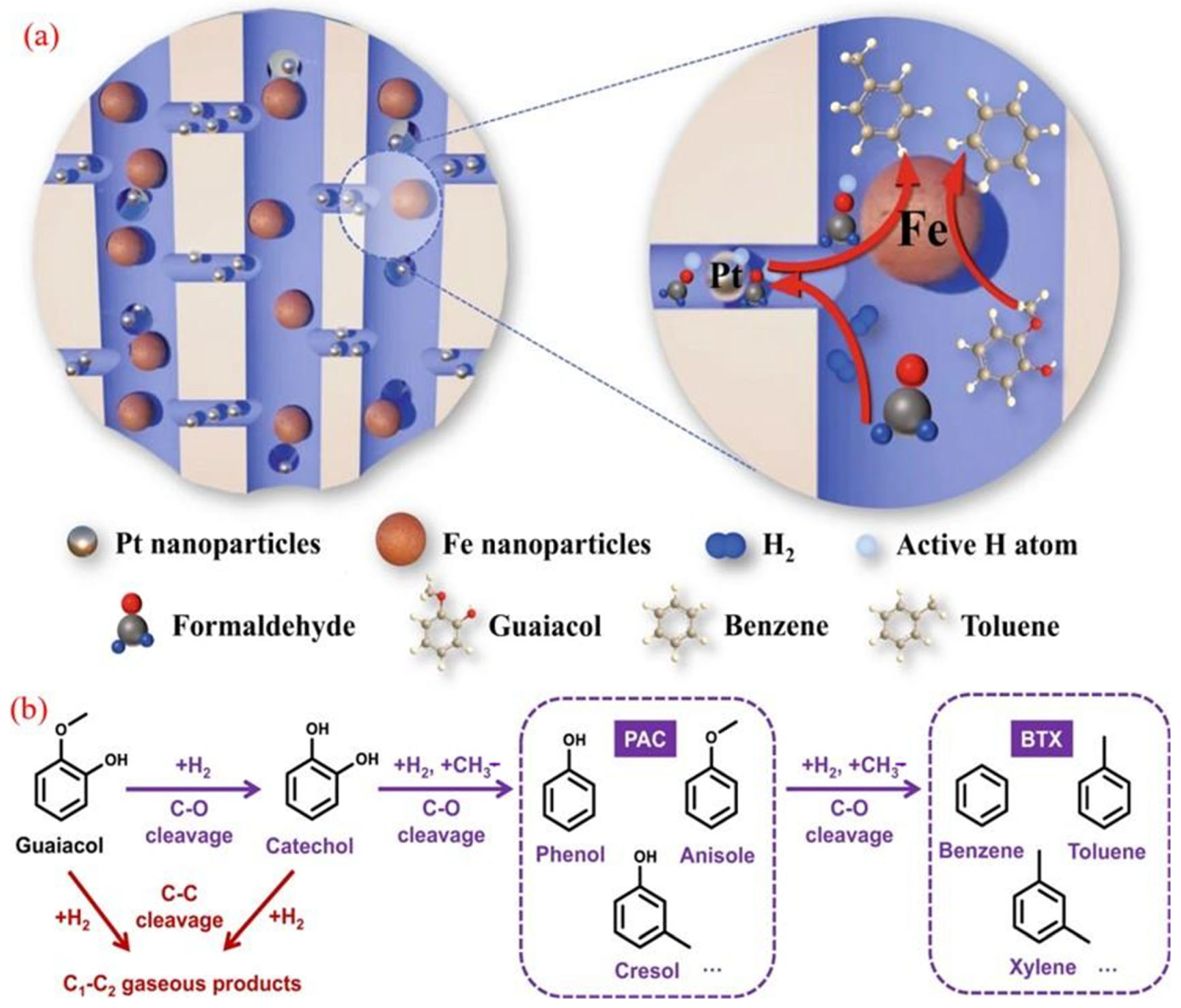
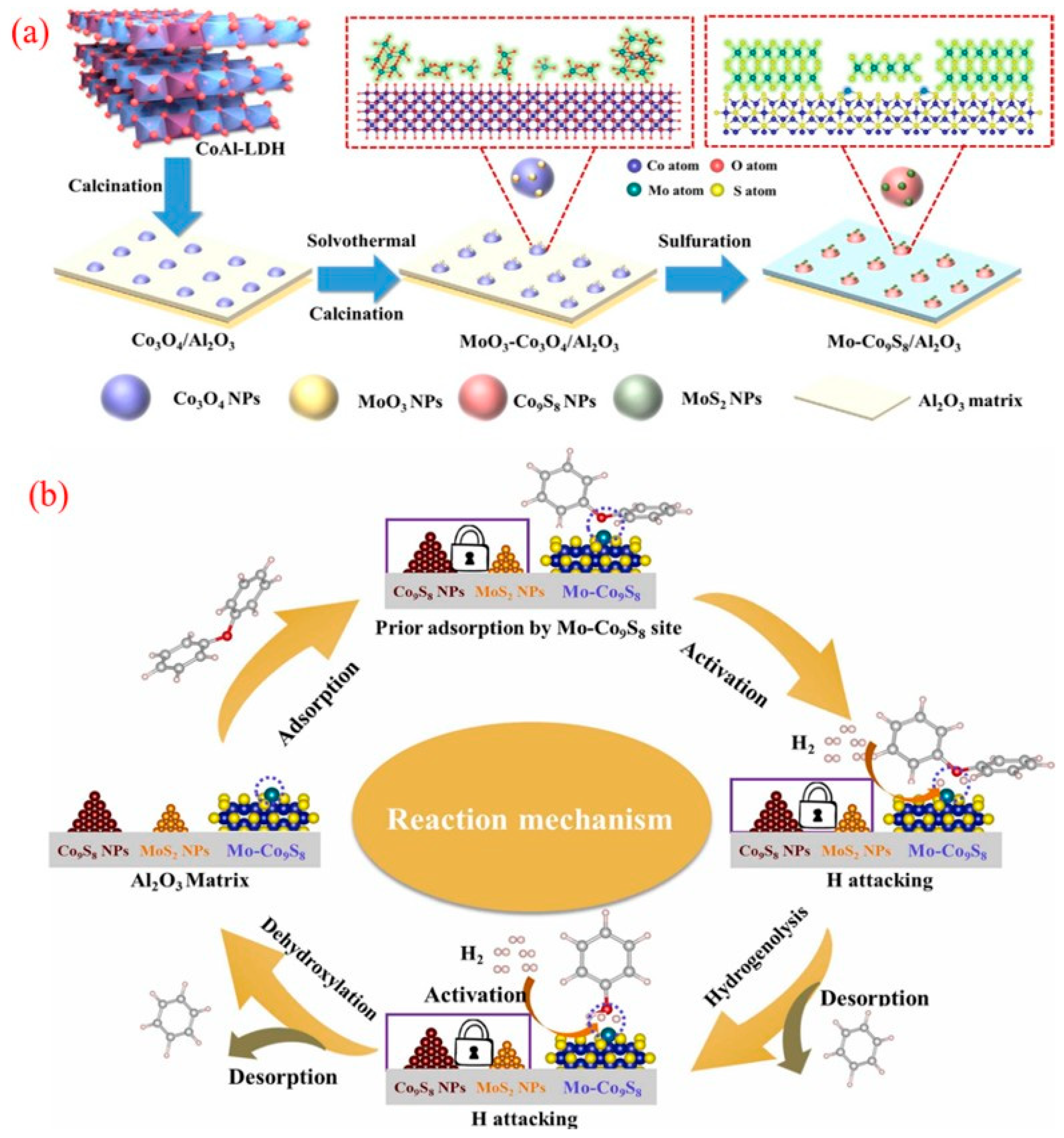

| Catalyst | Reaction Condition | Substrate | Conv. (%) | Products | Sel. (%) | Ref. | |||
|---|---|---|---|---|---|---|---|---|---|
| T (°C) | P (bar) | Solvent | Reactor | ||||||
| Pd/Fe2O3 | 300 | ~1.01 | -- | fixed-bed | m-cresol | ~55 | BTX | 94 | [43] |
| Pd/Nb2O5 | 300 | 1 | -- | fixed-bed | phenol | 6.6 | benzene | 80.2 | [44] |
| Pd/TiO2 | 300 | 1 | -- | continuous-flow | phenol | 7.0 | benzene | 66.8 | [46] |
| Pd/ZrO2 | 300 | 1 | -- | fixed-bed | phenol | 77 | benzene | 66 | [160] |
| Pd/Nb2O5 | 300 | 1 | -- | fixed-bed | m-cresol | 13.1 | toluene | 95.6 | [47] |
| Pd/TiO2 | 300 | 1 | -- | fixed-bed | m-cresol | 7.3 | toluene | 80.0 | [47] |
| Pd/ZrO2 | 300 | 1 | -- | fixed-bed | m-cresol | 14.7 | toluene | 87.9 | [47] |
| Pd/t-ZrO2 | 300 | 1.01 | -- | fixed-bed | phenol | 86 | benzene | 44.2 | [161] |
| Pd/SiO2-Al2O3 | 450 | 1 | -- | continuous-flow | guaiacol | 83 | BTX | 73 | [162] |
| Ru/Nb2O5 | 250 | 5 | water | fixed-bed | p-cresol | 100 | toluene | 80 | [48] |
| Ru/Nb2O5 | 250 | 5 | water | fixed-bed | cresol | 100 | BTX | 80 | [48] |
| Ru/Nb2O5-MC | 250 | 2 | decalin/water mixed | batch | phenol | 100 | benzene | 80 | [51] |
| Ru/Nb2O5-SiO2 | 230 | -- | 2-PrOH | batch | p-cresol | 98.5 | toluene | 84.0 | [52] |
| Ru/TiO2 | 300 | 37.9 | water as additive | batch | phenol | 30 | benzene | 95 | [53] |
| Ru/TiO2 | 300 | 10 | decane | batch | anisole | 81 | benzene | 79 | [86] |
| Ru/TiO2 | 200 | 5 | decane | batch | anisole | 41 | benzene | 50.2 | [163] |
| Ru/TiO2 +N2 | 220 | 1 | decalin | batch | p-cresol | 97.4 | toluene | 98.4 | [54] |
| Ru/HZSM-5 | 240 | 2 | water | batch | guaiacol | 100 | benzene | 95 | [55] |
| Ru/HZSM-5 | 240 | 2 | water | batch | anisole | 100 | benzene | 94.4 | [55] |
| Ru/HZSM-5 | 240 | 2 | water | batch | phenol | 100 | benzene | 100 | [55] |
| Ru/HZSM-5 | 240 | 2 | water | batch | 4-methylguaiacol | 100 | toluene | 93 | [55] |
| Ru/HZSM-5 | 240 | 2 | water | batch | syringol | 100 | toluene | 95 | [55] |
| Ru/HZSM-5 | 240 | 2 | water | batch | syringol | 100 | benzene | 94 | [164] |
| Ru/LaCO3OH | 240 | 2 | water | batch | guaiacol | 95.6 | benzene | 75.8 | [165] |
| Ru/C | 400 | 40 | -- | fixed-bed | guaiacol | 100 | benzene | 69.5 | [166] |
| Ru/MoOx-ZrO2 | 250 | 10 | deionized water | steel autoclave | anisole | 77.6 | benzene | 84.7 | [56] |
| Pt/Hbeta | 400 | 1 | -- | continuous-flow | cresol | 100 | BTX | >90 | [57] |
| Pt/Hbeta | 400 | 1 | -- | continuous-flow | anisole | 100 | BTX | 90 | [58] |
| Pt/Hbeta | 350 | 1 | -- | continuous-flow | guaiacol | 90 | BTX | 85 | [60] |
| Pt/SiO2 | 400 | 1 | -- | continuous-flow | cresol | 91 | toluene | >75 | [57] |
| Pt/SiO2 | 400 | 1 | -- | continuous-flow | anisole | 100 | BTX | 69 | [58] |
| Pt/TiO2 | 300 | 1 | -- | continuous-flow | cresol | 17 | toluene | 88 | [167] |
| Pt/TiO2 | 350 | 5 | -- | packed-bed | m-cresol | 35 | toluene | 78 | [61] |
| Pt/ZrO2 | 300 | 1 | -- | continuous-flow | cresol | 12 | toluene | 67 | [167] |
| Pt/UiO-66-def | 270 | 10 | decane | fixed-bed | anisole | 70–86 | benzene | 52 | [168] |
| Pt/C | 350 | 5 | -- | packed-bed | m-cresol | 35 | toluene | 46 | [61] |
| MoO3 | 325 | 1 | -- | continuous-flow | cresol | 48.9 | BTX | 99.4 | [66] |
| MoO3 | 340 | 35 | octane | batch | phenol | 98.1 | benzene | 99.5 | [62] |
| MoO3 | 340 | 35 | octane | batch | anisole | 98.2 | BT | 78.3 | [62] |
| MoO3 | 340 | 35 | octane | batch | guaiacol | 98.0 | BT | 82.7 | [62] |
| MoO3 | 340 | 35 | octane | batch | cresol | 78.9 | BT | 98.5 | [62] |
| MoO3-SiO2 | 340 | 5 | -- | fixed-bed | phenol | 89.6 | benzene | 84.3 | [169] |
| MoO3-SiO2 | 340 | 5 | -- | fixed-bed | p-cresol | 90.7 | toluene | 81.2 | [169] |
| MoO3-SiO2 | 340 | 5 | -- | fixed-bed | anisole | 88.5 | BT | 76.0 | [169] |
| MoO3/ZrO2 | 320 | 1 | -- | continuous-flow | cresol | 78 | toluene | 77 | [67] |
| MoO3/TiO2 | 320 | 1 | -- | continuous-flow | cresol | 47 | toluene | 46 | [67] |
| MoO3/CeO2 | 320 | 1 | -- | continuous-flow | cresol | 8 | toluene | 7 | [67] |
| MoO3/Al2O3 | 320 | 1 | -- | continuous-flow | cresol | 13 | toluene | 10 | [67] |
| MoO3/SiO2 | 320 | 1 | -- | continuous-flow | cresol | 10 | toluene | 9 | [67] |
| MoO3/TiO2 | 350 | 25 | -- | continuous-flow | phenol | 28 | benzene | 89 | [153] |
| MoOx/SiO2 | 340 | 40 | -- | continuous-flow | cresol | 23.8 | benzene | 81.9 | [68] |
| MoOx/SBA-15 | 340 | 40 | -- | continuous-flow | cresol | 23.9 | benzene | 82.8 | [68] |
| MoOx/Al2O3 | 340 | 40 | -- | continuous-flow | cresol | 22.1 | benzene | 85.5 | [68] |
| Ni/CeO2 | 290 | 3 | -- | continuous-flow | anisole | 88 | benzene | 55 | [74] |
| Ni/TiO2 | 290 | 3 | -- | continuous-flow | anisole | 51 | benzene | 74 | [74] |
| Ni/C | 290 | 3 | -- | continuous-flow | anisole | 95 | benzene | 51 | [74] |
| Ni/SBA-15 | 290 | 3 | -- | continuous-flow | anisole | 99 | benzene | 8 | [74] |
| Ni/Al2O3 | 290 | 3 | -- | continuous-flow | anisole | 99 | benzene | 27 | [74] |
| Ni/SiO2 | 300 | 1 | methanol | continuous-flow | phenol | 90 | benzene | 99 | [170] |
| Ni/Al2O3 | 260 | 1 | -- | continuous-flow | cresol | 30 | toluene | 67.8 | [171] |
| Ni/Ce0.3Nb0.7O2 | 300 | 1 | -- | continuous-flow | phenol | 9.53 | benzene | 86.92 | [77] |
| Ni/Nb2O5 | 300 | 1 | -- | continuous-flow | phenol | 10.10 | benzene | 89.96 | [77] |
| Ni@silicalite-1 | 250 | 2.5 | n-decane | fixed-bed | m-cresol | 78.4 | BT | 73.1 | [63] |
| Fe2O3 | 300 | 1 | -- | continuous-flow | cresol | 21 | BTX | 90 | [43] |
| Fe | 300 | 1 | -- | continuous-flow | m-cresol | 1–10 | toluene | >90 | [172] |
| Fe/NC-3.7 | 350 | 5 | -- | fixed-bed | m-cresol | 20.1 | toluene | 78.2 | [173] |
| Fe/SiO2 | 375 | 1 | -- | continuous-flow | anisole | 8 | benzene | 85 | [174] |
| Fe/SiO2 | 300 | 1 | -- | continuous-flow | m-cresol | 8.8 | toluene | 60.2 | [175] |
| Fe/SiO2 | 400 | 1 | -- | continuous-flow | guaiacol | 100 | BT | >90 | [176] |
| Cu/MnAlOx | 300 | 20 | n-decane | stainless autoclave | anisole | 54 | benzene | 65 | [78] |
| PdFe/C | 450 | 1 | -- | continuous-flow | guaiacol | 100 | benzene | 83.2 | [84] |
| RuFe/meso-TiO2 | 250 | 1 | decane | batch | anisole | 98 | benzene | >80 | [86] |
| FeReOx/ZrO2 | 350 | 1 | -- | batch | anisole | 100 | BTX | 48.3 | [26] |
| FeReOx/ZrO2 | 350 | 1 | -- | batch | m-cresol | 100 | BTX | 61.7 | [26] |
| FeReOx/ZrO2 | 350 | 1 | -- | batch | guaiacol | 100 | BTX | 21.6 | [26] |
| FeReOx/MCM-41 | 350 | 1 | -- | batch | anisole | 100 | BTX | 25.8 | [26] |
| FeReOx/MCM-41 | 350 | 1 | -- | batch | m-cresol | 100 | BTX | 29.6 | [26] |
| FeReOx/MCM-41 | 350 | 1 | -- | batch | guaiacol | 100 | BTX | 8.0 | [26] |
| FeReOx/HBeta | 350 | 1 | -- | batch | m-cresol | 100 | BTX | 42.4 | [26] |
| 1Pt@-10Fe@SiO2 | 450 | 5 | -- | fixed-bed | guaiacol | 96.3 | BTX | 48.8 | [88] |
| NiFe/SiO2 | 300 | 1 | -- | continuous-flow | cresol | 13.7 | toluene | 52.6 | [65] |
| NiMo/SiO2 | 410 | 1 | -- | continuous-flow | phenol | 99.3 | benzene | 99.27 | [91] |
| NiMo/SiO2 | 410 | 1 | -- | continuous-flow | anisole | 99.35 | BTX | 98.55 | [91] |
| NiMo/SiO2 | 410 | 1 | -- | continuous-flow | guaiacol | 99.79 | BTX | 97.53 | [91] |
| NiMo/SiO2 | 350 | 1 | -- | continuous-flow | m-cresol | 100 | toluene | >80 | [92] |
| Ni40In/SiO2 | 300 | 1 | -- | fixed-bed | anisole | 97 | BTX | 60.4 | [93] |
| NiGa/SiO2 | 300 | 1 | -- | fixed-bed | anisole | 31 | benzene | 92.6 | [96] |
| PB-Hβ-8/Ni-V | 350 | 1 | -- | fixed-bed | guaiacol | 100 | BT | 69.17 | [97] |
| NiRe/SiO2 | 300 | 1.01 | -- | fixed-bed | m-cresol | 47.6 | toluene | 50 | [95] |
| NiReOx/ZrO2 | 350 | 1 | -- | continuous-flow | m-cresol | 63.9 | BTX | 90 | [99] |
| Ni-ReOx/CeO2 | 350 | 1 | -- | continuous-flow | m-cresol | 45.7 | BTX | 83 | [99] |
| Ni-ReOx/ZrCeO2 | 350 | 1 | -- | continuous-flow | m-cresol | 42.5 | BTX | 80 | [99] |
| PdReOx/ZrO2 | 350 | 1 | -- | continuous-flow | m-cresol | 80 | BTX | 77.2 | [99] |
| Re-MoOx/TiO2 | 300 | 30 | dodecane | batch | anisole | 10 | BTX | ~50 | [101] |
| Re-VOx/TiO2 | 300 | 30 | dodecane | batch | anisole | 10 | BTX | ~56 | [101] |
| Re-MoOx/TiO2 | 300 | 50 | dodecane | batch | anisole | 35 | benzene | 83 | [100] |
| PtWOx/C | 300 | 36 | dodecane | fixed-bed | m-cresol | 61 | toluene | 98 | [103] |
| RuW/SiO2 | 175 | 5 | water | batch | anisole | 100 | benzene | 99.2 | [104] |
| RuWOx/SiAl | 220 | 10 | water | batch | phenol | 100 | benzene | 77 | [102] |
| RuWOx/ZrO2 | 220 | 10 | water | batch | phenol | 100 | benzene | 65 | [102] |
| Pt-Mo/CNT | 300 | 1 | -- | continuous-flow | dihydroeugenol | 100 | BTX | 93.2 | [176] |
| PtSn/CNF/Inconel | 400 | 1 | -- | continuous-flow | anisole | 74 | benzene | 80 | [177] |
| CoMoS | 300 | 40 | decalin | batch | guaiacol | 100 | benzene | 86 | [112] |
| CoMoS | 300 | 40 | decalin | batch | phenol | 100 | benzene | 100 | [112] |
| CoMoS | 300 | 40 | decalin | batch | cresol | 100 | benzene | 100 | [112] |
| CoMoS | 300 | 40 | -- | fixed-bed | guaiacol | 50 | benzene | 42 | [178] |
| CoMoS-0.18 | 250 | 30 | decalin | sealed autoclave | p-cresol | 92.4 | toluene | 95.5 | [113] |
| Co-MoS2-2 | 250 | 30 | decalin | autoclave | p-cresol | 92.7 | toluene | 94.1 | [114] |
| CoMoS/Al2O3 | 340 | 40 | dodecane | batch | m-cresol | 19.6 | toluene | 28 | [179] |
| CoMoS/Al2O3 | 300 | 15 | xylene | continuous-flow | phenol | 71.9 | benzene | 86.4 | [180] |
| CoMoS/Al2O3 | 300 | 15 | xylene | continuous-flow | anisole | 96.8 | BT | 32.5 | [180] |
| CoS2/MoS2 | 250 | 40 | dodecane | batch | p-cresol | 98 | toluene | 99 | [181] |
| Mo0.06-Co9S8/Al2O3 | 265 | 30 | methylcyclohexane | batch | phenol | 95.7 | benzene | 89.6 | [115] |
| Mo0.06-Co9S8/Al2O3 | 265 | 30 | methylcyclohexane | batch | p-cresol | 98.2 | toluene | 89.2 | [115] |
| Mo0.06-Co9S8/Al2O3 | 265 | 30 | methylcyclohexane | batch | guaiacol | 99.5 | BT | 71.0 | [115] |
| Mo0.06-Co9S8/Al2O3 | 265 | 30 | methylcyclohexane | batch | anisole | 99.7 | benzene | 80.1 | [115] |
| Mo0.06-Co9S8/Al2O3 | 265 | 30 | methylcyclohexane | batch | catachol | 99.8 | benzene | 72.4 | [115] |
| Co-MoS2-x | 200 | 40 | dodecane | batch | 4-methylphenol | 97.4 | toluene | 99.6 | [116] |
| MoS2 | 300 | 40 | dodecane | batch | p-cresol | 67.0 | toluene | 74.1 | [116] |
| NiS2 | 300 | 40 | dodecane | batch | p -cresol | 32.4 | toluene | 55.6 | [116] |
| Ni-S+MoS2 | 300 | 40 | dodecane | batch | p -cresol | 59.2 | toluene | 84.6 | [119] |
| Mo-W-S | 300 | 30 | decalin | batch | 4-methylphenol | 50 | toluene | 89 | [182] |
| Ni-Mo-W-S | 300 | 30 | decalin | batch | 4-methylphenol | 100 | toluene | 99.4 | [182] |
| MoP/SiO2 | 300 | 1.01 | -- | continuous-flow | guaiacol | 54 | benzene | 53 | [178] |
| MoP/TiO2 | 350 | 25 | decane | continuous-flow | phenol | 25 | benzene | 82 | [153] |
| MoP-CA | 500 | 44 | decalin | batch | 4-methylphenol | 58 | toluene | 60 | [183] |
| Co2P/SiO2 | 300 | 1.01 | -- | continuous-flow | guaiacol | 70 | benzene | 52 | [178] |
| Fe2P | 200 | 1.01 | -- | batch | anisole | 100 | benzene | 96.7 | [135] |
| FeMoP | 400 | 21 | decalin | batch | phenol | >99 | benzene | ~90 | [123] |
| FeMoP | 400 | 21 | decalin | batch | anisole | 90 | benzene | 92 | [123] |
| Ni2P/SiO2 | 300 | 1.01 | -- | continuous-flow | guaiacol | 80 | benzene | 60 | [178] |
| Ni2P/SiO2 | 300 | 1.4 | -- | fixed-bed | guaiacol | >99 | benzene | 72 | [184] |
| Ni2P/SiO2 | 300 | 10 | -- | fixed-bed | guaiacol | 64 | BTX | 60 | [126] |
| Ni2P/SiO2 | 300 | 1 | tridecane | continuous-flow | guaiacol | 85 | benzene | 62 | [129] |
| Ni2P/SiO2 | 400 | 15 | -- | continuous-flow | anisole | 100 | benzene | 60.6 | [130] |
| Ni2P/SiO2 | 300 | 1 | -- | continuous-flow | guaiacol | 55 | benzene | 86 | [131] |
| Ni2P/SiO2 | 300 | 1 | -- | continuous-flow | anisole | 71 | benzene | 81 | [134] |
| Mo2C | 350 | 27.6 | decane | batch | guaiacol | 78 | benzene | 22.1 | [148] |
| Mo2C | 250 | 1.013 | -- | fixed-bed | anisole | 49 | benzene | 87 | [146] |
| β-Mo2C | 350 | 4.4 | -- | continuous-flow | guaiacol | 99.8 | benzene | 87.8 | [185] |
| Mo2C | 60 | 10 | -- | continuous-flow | m-cresol | 21 | toluene | 95 | [186] |
| Mo2C | 150 | 1.31 | -- | fixed-bed | anisole | 40 | benzene | ~80 | [145] |
| Mo2C | 130 | 1 | -- | continuous-flow | anisole | 100 | benzene | >90 | [141] |
| Mo2C | 280 | 1.1 | -- | continuous-flow | phenolic mixture | 94 | BT | 93 | [142] |
| Mo2C/TiO2 | 350 | 25 | decane | continuous-flow | phenol | 65 | benzene | 91 | [153] |
| Mo2C/CNF | 350 | 55 | -- | batch | guaiacol | 45 | BT | 2 | [187] |
| Mo2C+FAU | 250 | 1.013 | -- | fixed-bed | anisole | 61 | BT | 40 | [146] |
| MoCx/FAU | 250 | 1.013 | -- | fixed-bed | anisole | 97 | BT | 10 | [146] |
| MoC-SiO2 | 32 | 60 | hexadecane | batch | anisole | 65 | benzene | ~70 | [147] |
| Mo2C-MoCxOy | 350 | 43 | decalin | batch | p-cresol | 25 | toluene | >75 | [144] |
| W2C | 171 | 1.31 | -- | fixed-bed | anisole | 100 | benzene | 96 | [145] |
| W2C/CNF | 350 | 55 | -- | batch | guaiacol | 66 | BT | 1 | [187] |
| NiMoC-SiO2 | 32 | 60 | hexadecane | batch | anisole | 95 | benzene | 20 | [147] |
| MoWC | 350 | 27.6 | decane | batch | guaiacol | 93 | BT | 76.4 | [148] |
| Mo2N/TiO2 | 350 | 25 | decane | continuous-flow | phenol | 9.1 | benzene | 90 | [153] |
Disclaimer/Publisher’s Note: The statements, opinions and data contained in all publications are solely those of the individual author(s) and contributor(s) and not of MDPI and/or the editor(s). MDPI and/or the editor(s) disclaim responsibility for any injury to people or property resulting from any ideas, methods, instructions or products referred to in the content. |
© 2025 by the authors. Licensee MDPI, Basel, Switzerland. This article is an open access article distributed under the terms and conditions of the Creative Commons Attribution (CC BY) license (https://creativecommons.org/licenses/by/4.0/).
Share and Cite
Dong, S.; Feng, G. A Comprehensive Review of Catalytic Hydrodeoxygenation of Lignin-Derived Phenolics to Aromatics. Molecules 2025, 30, 2225. https://doi.org/10.3390/molecules30102225
Dong S, Feng G. A Comprehensive Review of Catalytic Hydrodeoxygenation of Lignin-Derived Phenolics to Aromatics. Molecules. 2025; 30(10):2225. https://doi.org/10.3390/molecules30102225
Chicago/Turabian StyleDong, Sitong, and Gang Feng. 2025. "A Comprehensive Review of Catalytic Hydrodeoxygenation of Lignin-Derived Phenolics to Aromatics" Molecules 30, no. 10: 2225. https://doi.org/10.3390/molecules30102225
APA StyleDong, S., & Feng, G. (2025). A Comprehensive Review of Catalytic Hydrodeoxygenation of Lignin-Derived Phenolics to Aromatics. Molecules, 30(10), 2225. https://doi.org/10.3390/molecules30102225





